Some of the most colorful birds in the world are yellow. Many species of yellow birds are native to North America.
They live in vast territories from lowland marshes to pine woodlands and are found in their millions across the continent and around the world.
Yellow coloring is seen on species that share plumage nuances between males and females as well as just on males or just on females.
Often feeding on nectar and insects, these birds tend to be small to medium-sized, measuring anywhere between 3 and 8 inches.
Some of the yellow birds in North America are known to migrate to Southern parts of the continent, Central America, or even to South America to overwinter.
Flock movements in late fall or early spring are among the ideal times to spot these birds.
Others are residents of some of the most remote areas and islands of the world and are rarely seen.
The following yellow bird species are confirmed across the continents and many can still be spotted in their natural habitat in high numbers at least during the breeding season.
Table of Contents
1. Northern Cardinal
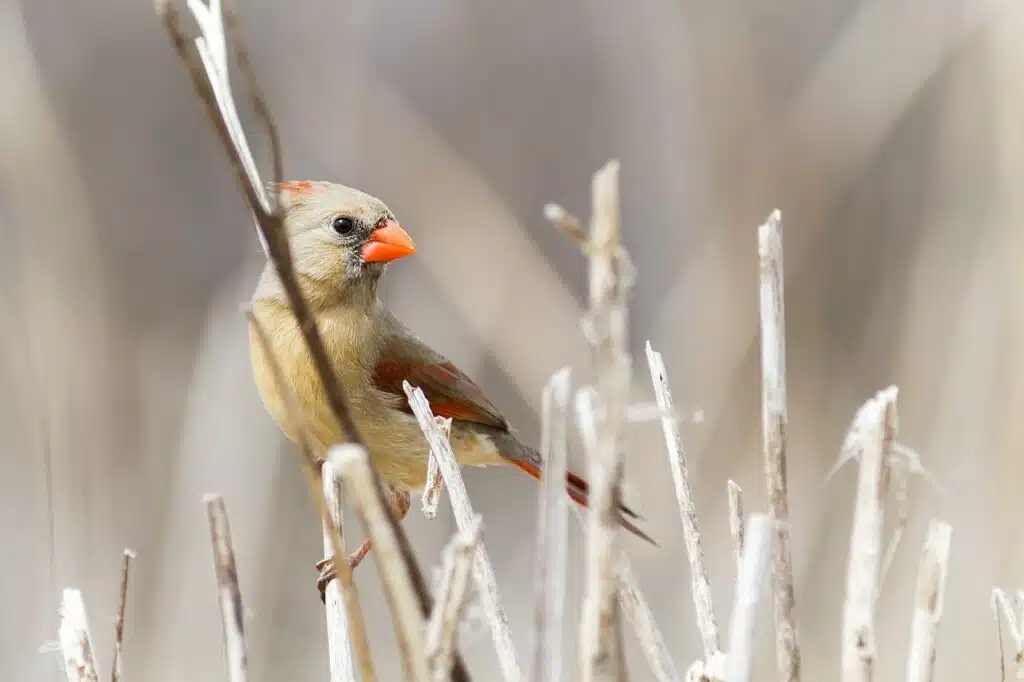
Northern Cardinals (Cardinalis cardinalis) are a good example of a common yellow bird. Females of the species show a mostly yellow-olive color while males are red as a result of diets rich in carotenoids.
The female bird shows a yellow belly with an olive head. Its wings are darker with red margins, similar to its red tails.
Females also show a red crest, similar to the red crest of males, coupled with a bright red beak.
Some yellow pigments are further distinguishable on the olive parts of the bird, but most yellow plumage dominates its belly and chest.
Named after Roman cardinals, these are some of the most common types of yellow birds in The Americas.
Both the red and the yellow males and females of the species are often seen across many states.
By some estimates, there are more than 100 million Northern Cardinals in North and Central America.
Distribution – Easter and Southern United States
2. Yellow Warbler
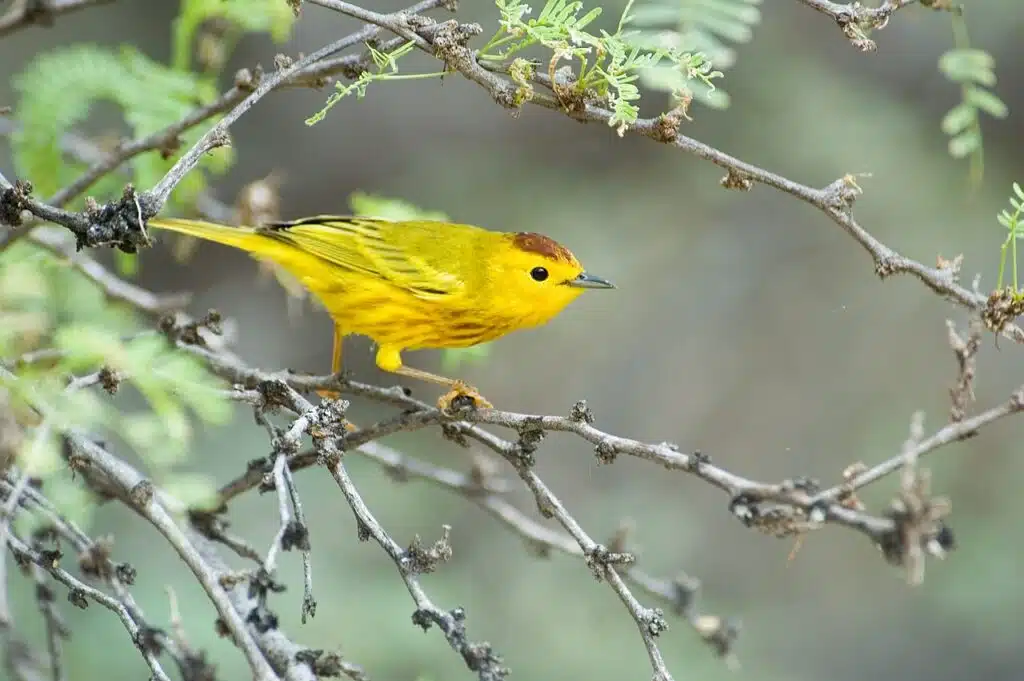
Yellow Warblers (Setophaga petechia) are seen across North America. These types of birds are mostly yellow but they come in numerous species where the plumage may have slightly different variations.
35 subspecies of Yellow Warblers have been identified.
These birds are further categorized by their region.
The American Yellow Warbler is a category numbering 6 subspecies where the male is yellow.
A vivid yellow underbelly is characteristic of these males. Yellow or yellow-green wings and tails are also seen on these birds.
Their heads can be all-yellow or yellow with red or red-brown crows. In some cases, Yellow Warblers may show a red-brown face instead of a yellow face.
Many of these birds are found in areas with plenty of caterpillars which make up the base of their diet.
Distribution – Canada, United States, Central America, Northern South America
3. Palm Warbler
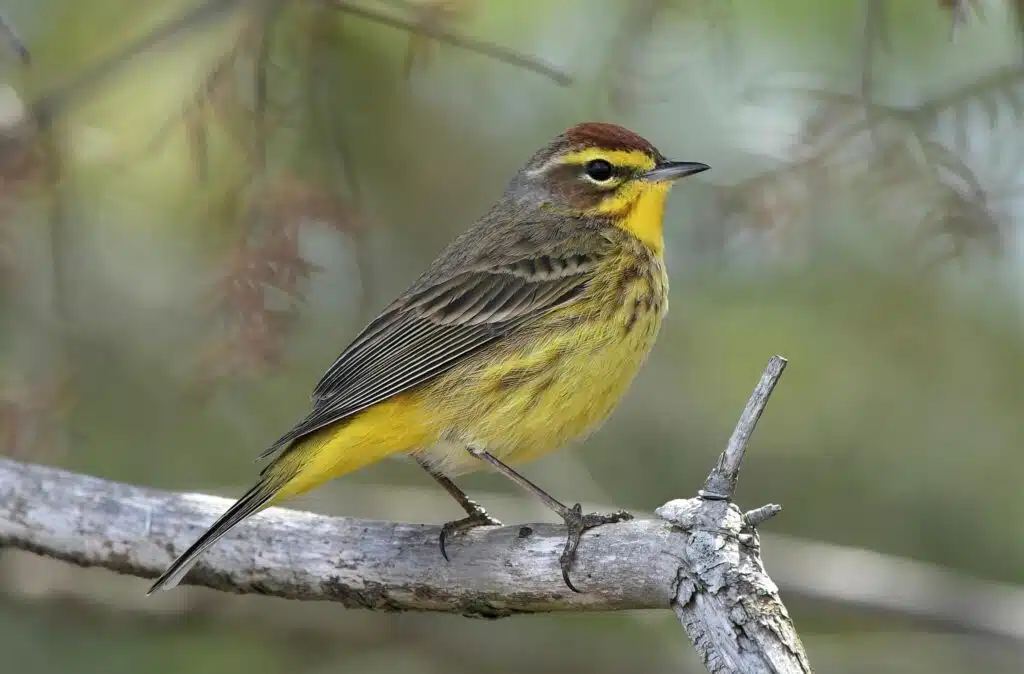
A bright yellow underbelly, chest, and face are seen on the breeding male Palm Warbler (Setophaga palmarum).
This species has gray-brown wings and a similarly-colored head. Its crown tends to become red into the breeding season.
Mature Palm Warblers can be differentiated from immatures by their yellow color.
Found across woodlands of North America, this type of bird may be seen in almost any habitat as it also migrates.
Some of its favorite migration destinations to overwinter include Southern US states as well as Northern Mexico.
Distribution – Canada, United States, The Caribbean, Mexico
4. Pine Warbler
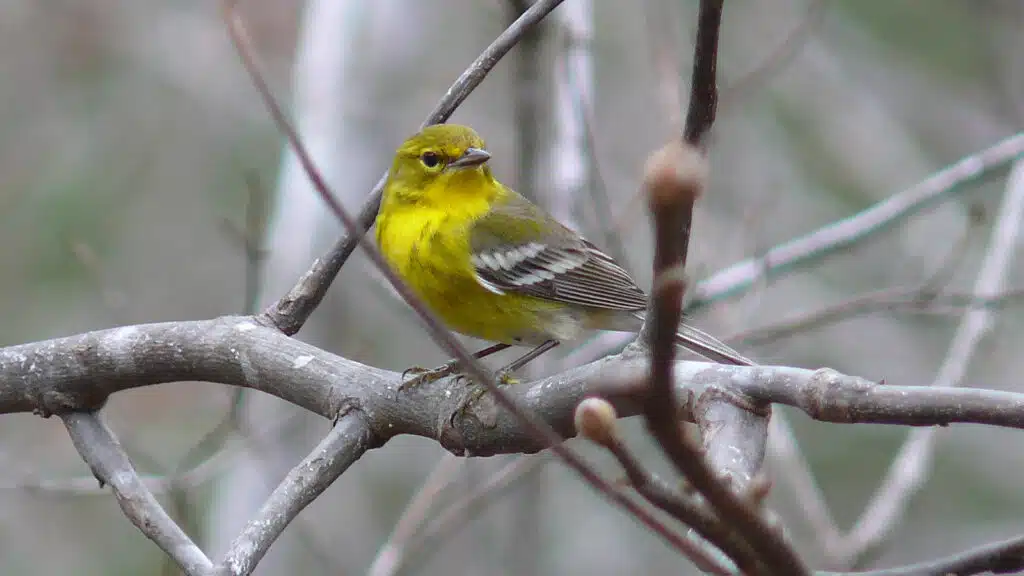
Reaching a size of just over 5 inches at best, Pine Warblers (Setophaga pinus) are somewhat similar to Palm Warblers.
These are birds found across various pine and mixed woodlands of North America.
Unlike Palm Warblers, they are only found in a limited range, mainly in the Eastern states.
A dark yellow color is specific to the male’s head and underbelly while the wings are gray, white, and black.
Females of the species show duller plumage. They have a bright gray appearance with darker gray wings.
One of the most common birds in pine woodlands, Pine Warblers are numerous species in the Eastern pine woodlands of The US.
Most of these birds aren’t seen outside pine woodlands but they may even be difficult to spot in their natural habitat as they fly high up on trees.
One of the few occasions to spot this bird is during its migration. Some Pine Warbler populations migrate to the Southern US states.
This is typically done in small numbers but groups of tens of Pine Warblers may still be spotted moving South.
Distribution – Eastern United States, Eastern Canada
5. Western Tanager
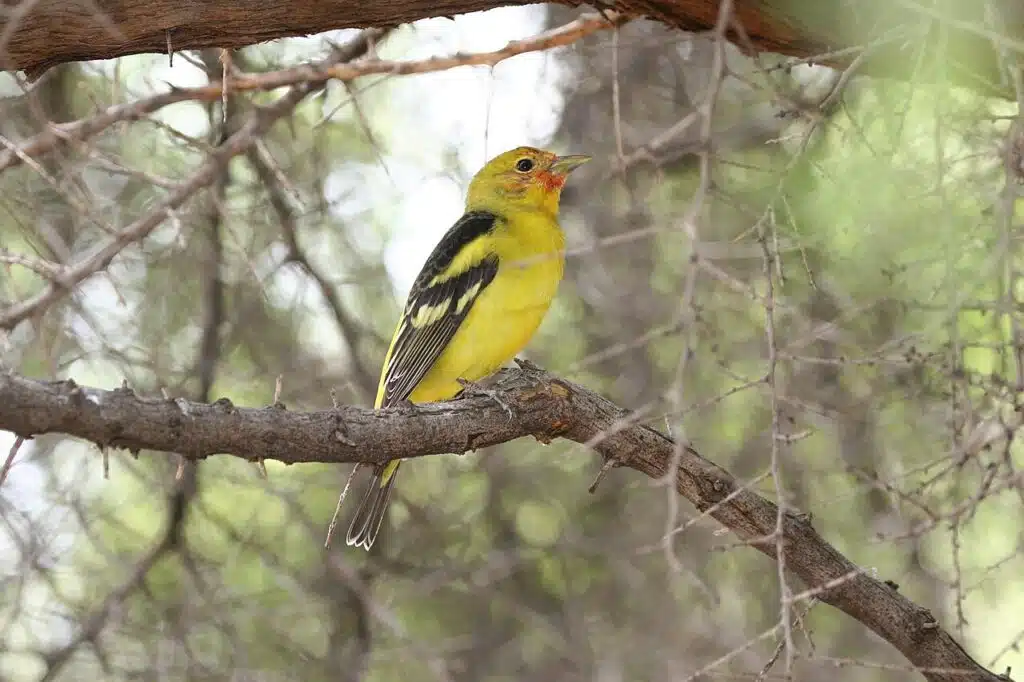
Vivid yellow plumage is also seen on The Western Tanager (Piranga ludoviciana). Some of the brightest yellow sections on the male bird include its belly, chest, and the back of its head.
The entire head of the male is yellow but its crown and face take on a red color during the breeding phase.
A combination of black base wings and yellow bands is a further characteristic of this species.
In addition, males also show a yellow beak color outside of the breeding season.
Unlike males, females are dull-colored, and dominated by gray nuances.
Distribution – Northwestern Canada, United States, Central America
6. Wilson’s Warbler
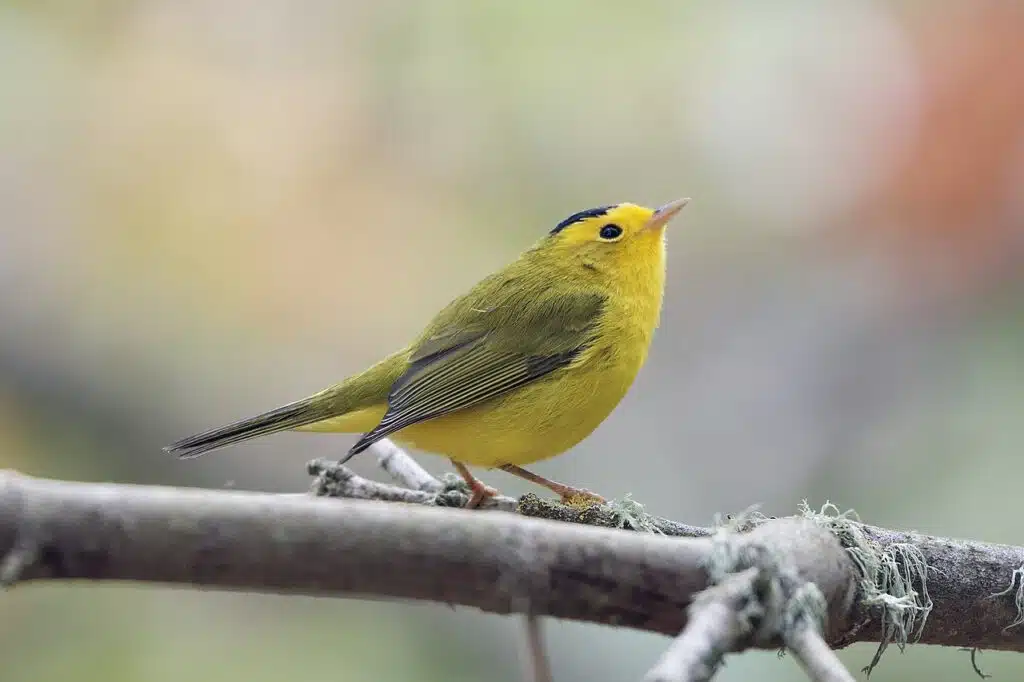
Wilson’s Warblers (Cardellina pusilla) are dominated by yellow and green nuances. Males of the species show a yellow head, neck, and underbelly.
This lemon-like yellow color is combined with its green wings and a breeding-signaling black crown.
A dual-color black and yellow beak further confirms the male is in the breeding season.
Females also show yellow plumage and are responsible for building the nests.
In most cases, the nest is built on shrubs or trees, just a few feet above the ground.
Distribution – Northwestern North America, The Gulf of Mexico, Central America
7. Magnolia Warbler
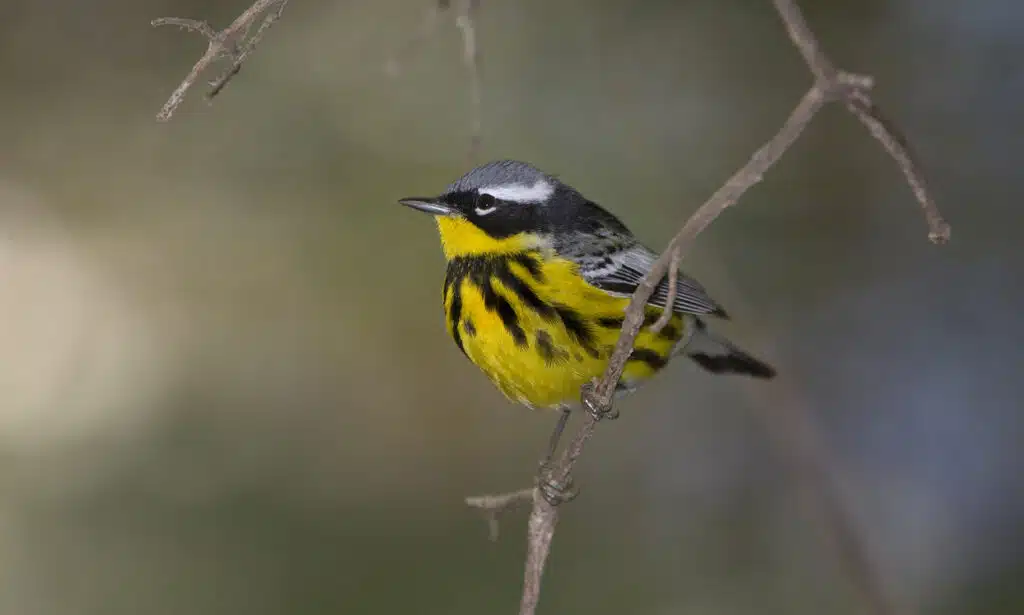
Magnolia Warblers (Setophaga magnolia) mostly live in the Northern and Northeastern parts of North America.
These migratory birds have a changing appearance as they grow, but yellow is the base color of their plumage.
A yellow chest and belly are specific to the male which has gray wings and a gray head.
Once it matures, black stripes run along its chest and belly. Black strips also appear around its head and wings.
Once it breeds, The Magnolia Warbler lays eggs and then migrates to Central America to overwinter.
Distribution – Northern and Eastern Canada, Northeastern United States, Central America, and The Caribbean
8. Black-throated Green Warbler
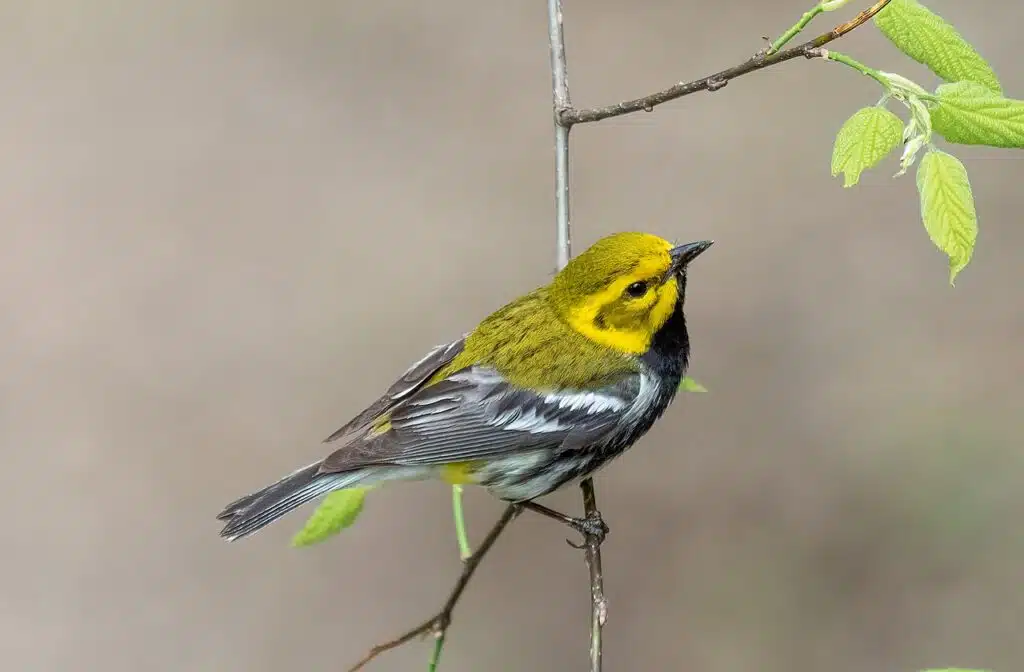
A migrating species of the Northeastern territories of North America, Black-throated Green Warblers (Setophaga virens) share considerable yellow plumage areas between males and females.
The male has fewer yellow sections, mainly across the belly and the face. Its crown and upper back have a bright green-olive color while its wings are black and white.
Its chest shows black and white colors as well.
Females also have yellow plumage on the belly and the face. They generally have smaller black areas on the chest.
Unlike Magnolia Warblers that like caterpillars, Black-throated Green Warblers prefer insects
Distribution – Northeastern North America, Central America
9. Nashville Warbler
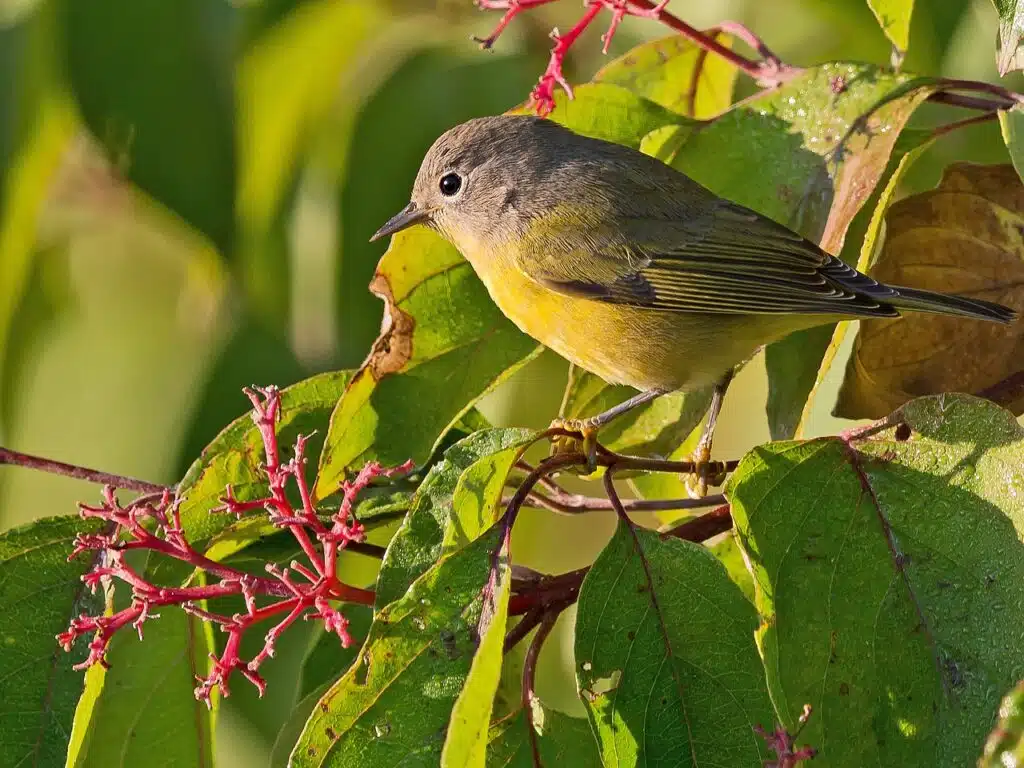
A widespread species in The United States, Nashville Warblers (Leiothlypis ruficapilla) are marked by their yellow plumage across the sexes.
A bright yellow belly and neck are specific to these birds which show contrasting upper gray sections. Their wings are gray and olive, with a gray head.
Yellow rings may also be seen around the eyes outside of the breeding period.
Growing to a size between 4 and 5 inches, these birds breed and migrate. Their eggs are mostly white, with red speckles.
Distribution – Northeastern North America, Western North America, Central America
10. Common Yellowthroat
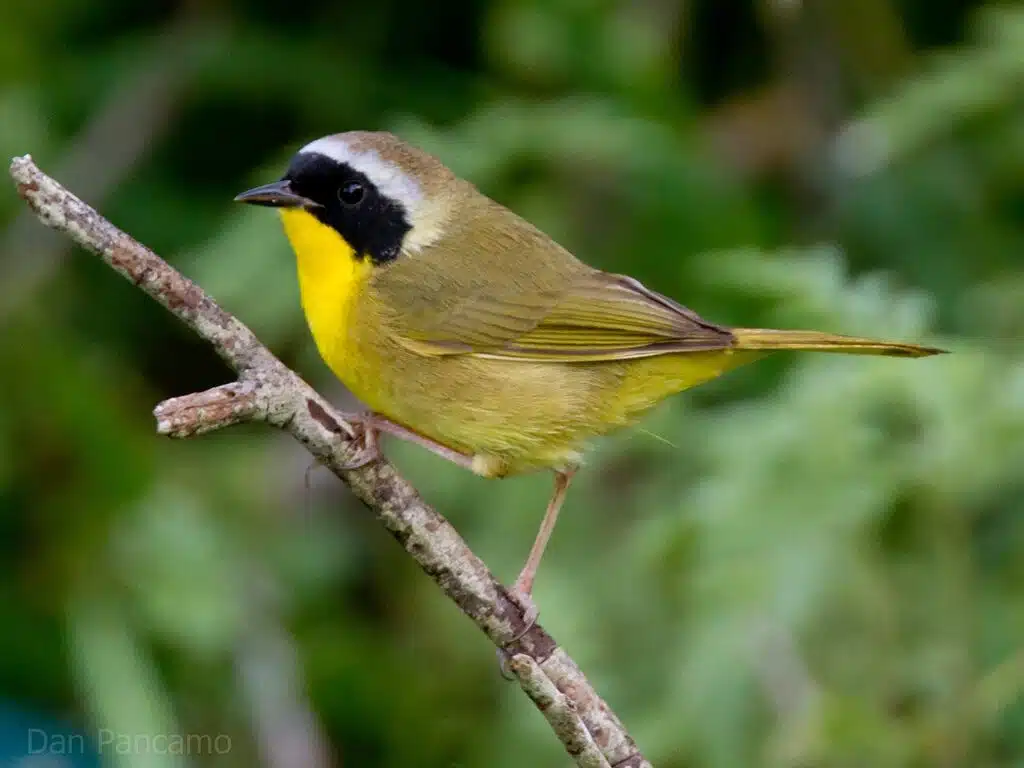
The Common Yellowthroat (Geothlypis trichas) also grows to a size between 4 and 5 inches, similar to The Nashville Warbler.
These are birds with a different appearance, on the other hand.
A yellow throat with yellow-green underbellies is specific to males. The male bird has a rare black face with brown-gray crowns and wings.
Females of the species show a pale yellow underbelly and gray upper plumage and feathers on the wings.
This species migrates in large numbers but it also has stable resident populations in the Southeast.
Distribution – North America, Central America, The Caribbean
11. Prothonotary Warbler
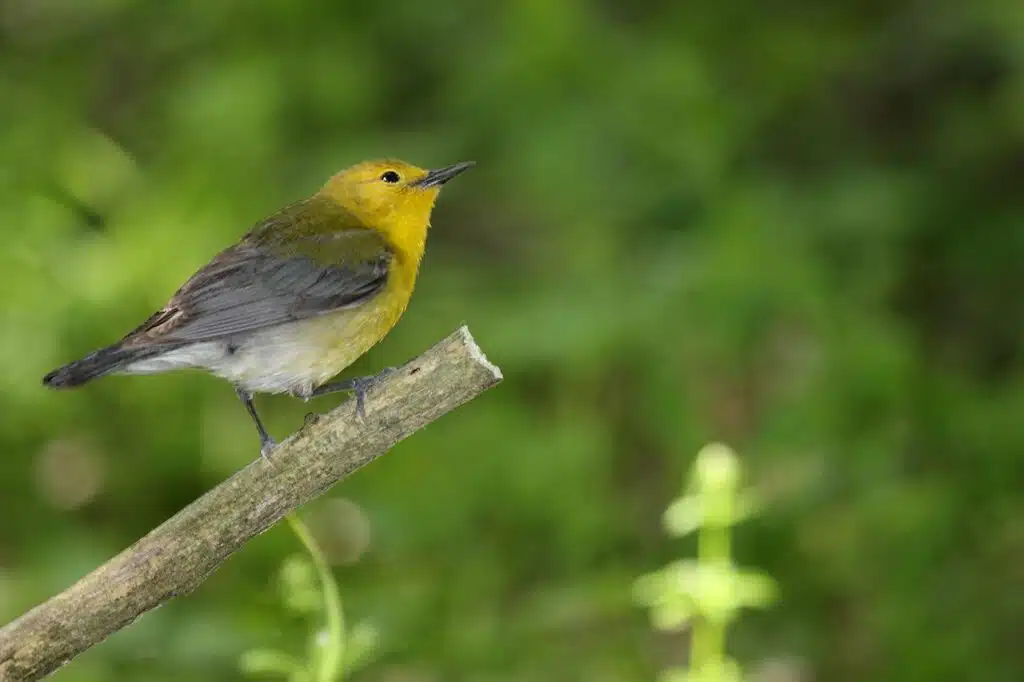
Woodlands and riparian areas are the habitat of Prothonotary Warblers (Protonotaria citrea) in North America.
This bird species grows up to a size of 5 inches, similar to other warblers.
It shares yellow plumage between males and females.
A bright yellow belly and head are specific to the male. Females also have a yellow head but show an additional gray crown.
The upper back and the base wings are also yellow while the rest of its wings are gray on males.
Females tend to have an olive base color of the wings.
Distribution – United States, Canada, West Indies
12. Cape May Warbler
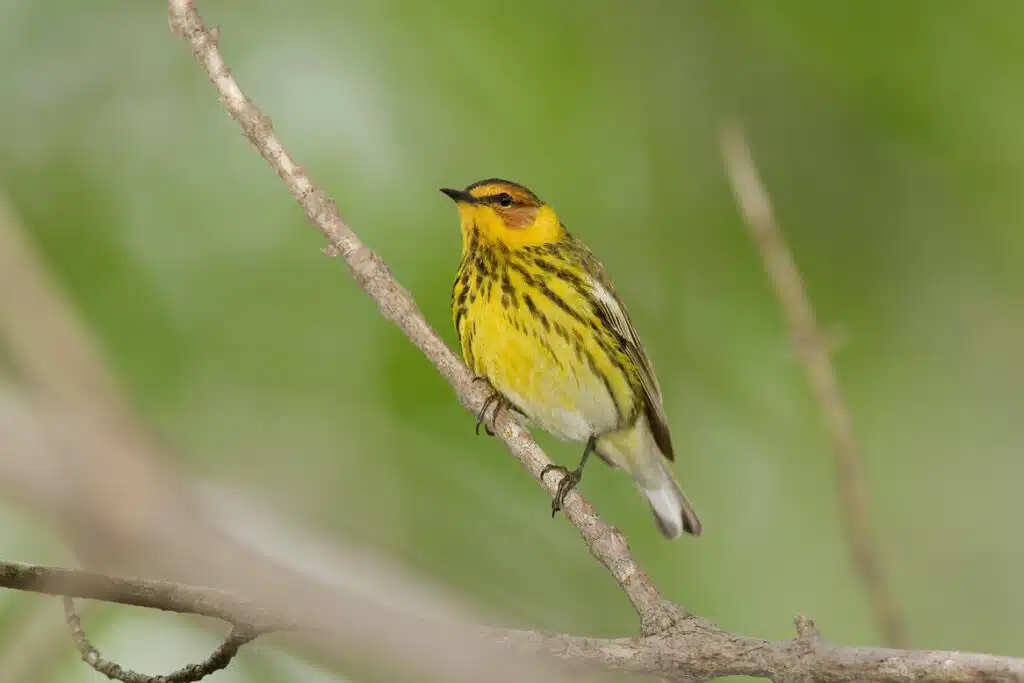
Feeding on moths such as Spruce Budworms, The Cape May Warbler (Setophaga tigrina) is slightly larger than other warblers and mostly found in Canada during the breeding season.
This species may grow to 5.5 inches, sharing yellow plumage both on males and females.
Yellow sections dominate the face and chest of males. A brown mask and a black crown complete its multicolored head appearance.
The yellow chest of the males also shows black contrasting streaks.
Female birds show similar black and yellow chests but their face masks are olive and not brown as on males.
Distribution – Southeastern and Central Canada, East Mexico, The Caribbean
13. Prairie Warbler
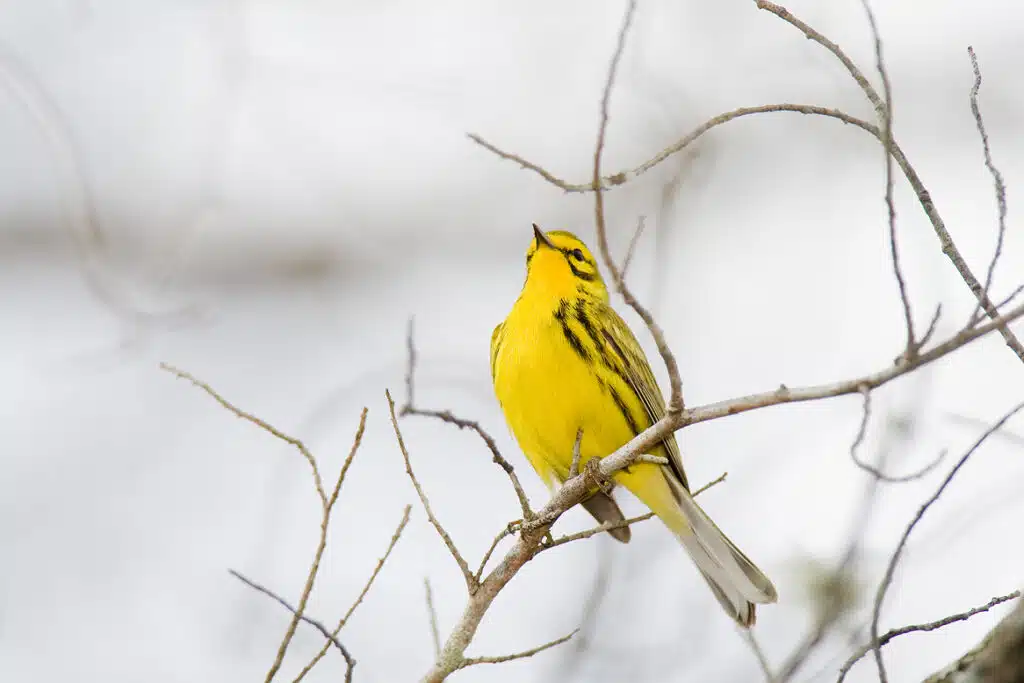
Mostly yellow plumage is specific to The Prairie Warbler (Setophaga discolor), one of the most common warblers of Florida.
This species shows a yellow face and a yellow underbelly with black streaks in the case of males and faded black streaks in the case of females.
A brown patch on the upper back is seen on males, differentiating them from breeding females.
The color of the wings further separates males from females. Largely black wings are specific to males while females show gray wings without additional olive coloring at the base.
Distribution – Eastern United States, West Indies
14. Evening Grosbeak
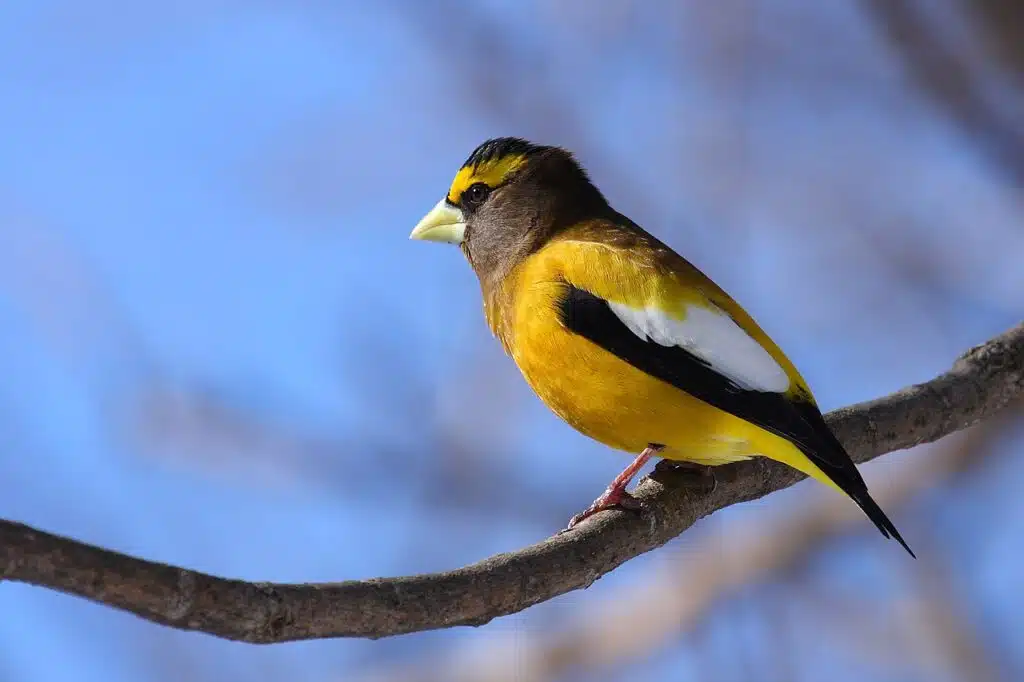
Reaching a size of almost 9 inches, Evening Grosbeaks (Coccothraustes vespertinus) are among the larger yellow birds of North America.
Yellow plumage is seen both on males and females but males are mostly yellow.
They show a yellow underbelly and a yellow face with additional darker yellow sections at the base of their black wings.
The head of males is mostly black while their bills have a pale yellow nuance.
Female Evening Grosbeaks are mostly gray with reduced yellow sections just around the head.
The color of the beak also separates males from females. A bright blue color is specific to the beak of the females.
Distribution – United States, Southern Canada
15. Hooded Warbler
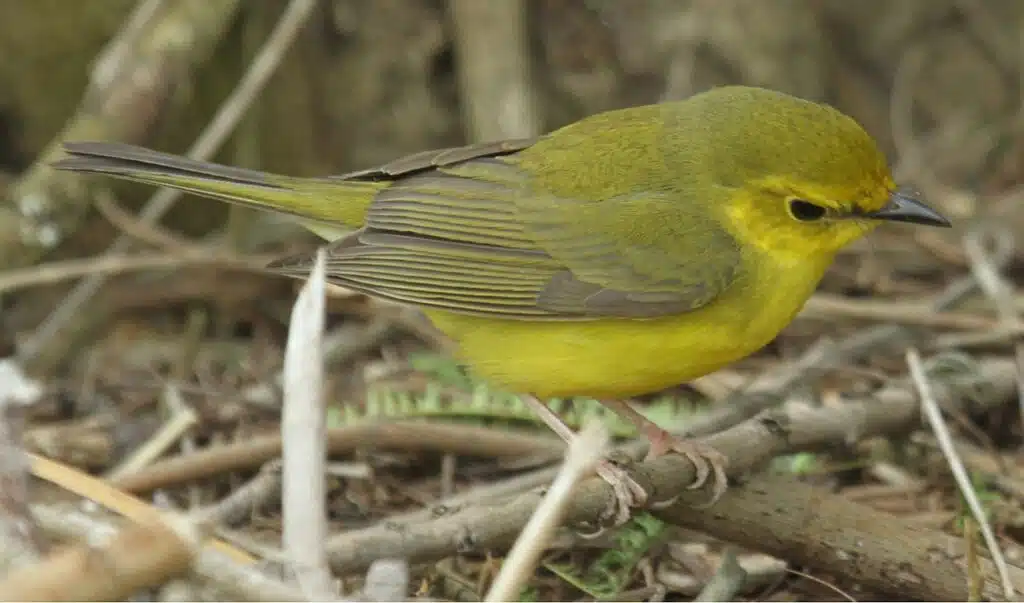
Yellow coloring is specific to both male and female Hooded Warblers (Setophaga citrina).
However, they are separated by plumage patterns as males show mostly black caps with yellow faces and black necks.
Females have a bright yellow head with an olive crown. The underbellies are yellow both on males and females.
The coloring of the wings is also slightly different for males and females. Males have dark green wings while females have olive wings.
Juvenile Hooded Warblers share the same colors and patterns as females.
Distribution – Eastern and Southeastern United States, Eastern Central America
16. Lesser Goldfinch
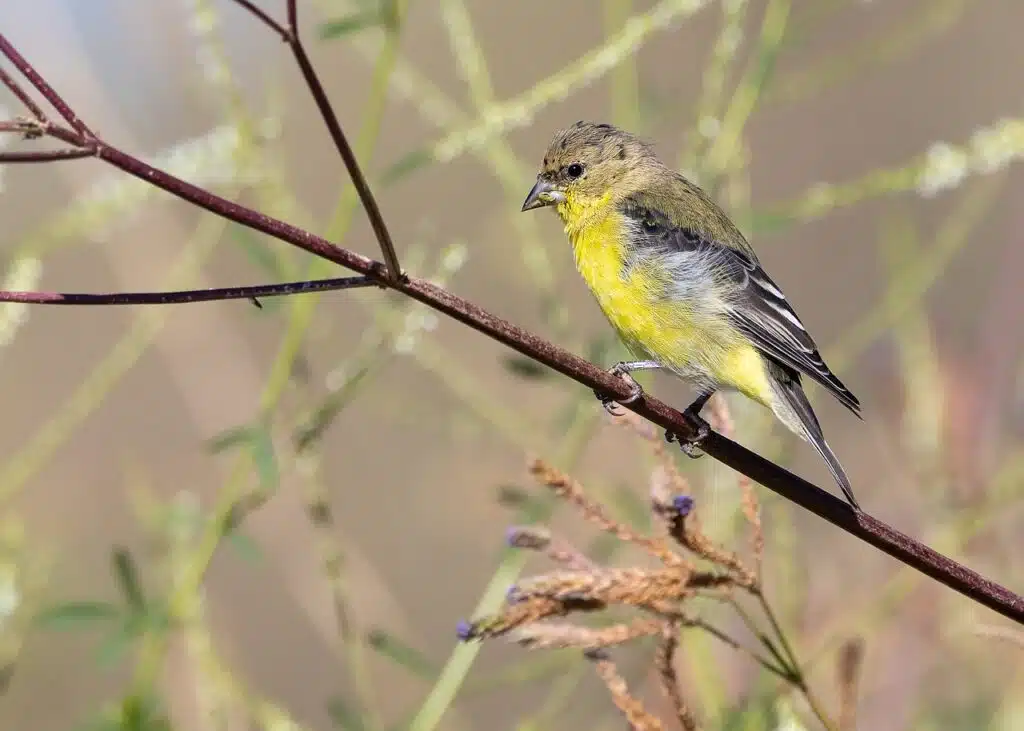
Mostly found in California and tropical regions of The Americas, Lesser Goldfinches (Spinus psaltria) are characterized by their bright yellow underbellies.
This is a characteristic mostly specific to males as females have pale yellow-gray underbellies.
The yellow color is seen up to the neck of the male as its head is black. Its wings are also mostly black, with only a few yellow feathers.
Females have an olive-yellow head with black and white wings.
While some populations in The US migrate, Lesser Goldfinch is a year-round resident of tropical areas.
Distribution – Western North America, Central America, Northwestern South America
17. Canada Warbler
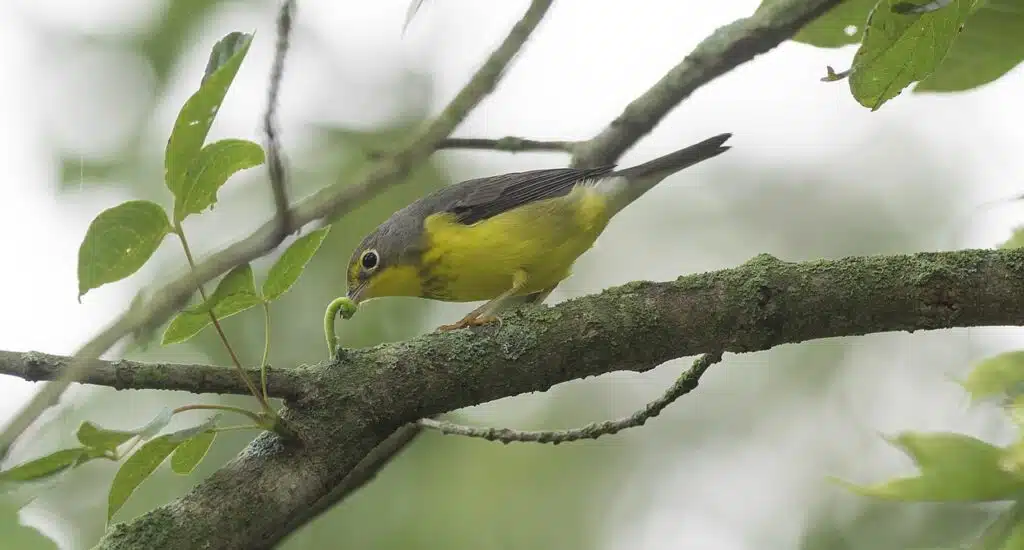
Canada Warbler (Cardellina canadensis) is a native Canadian yellow bird that migrates to South America for the coldest months of the winter.
Small Canadian Warbler populations are also found in The United States.
Both males and females of the species share different yellow plumage nuances.
Females tend to have the brightest yellow plumage while males only have bright yellow patches on the neck since their underbellies are green-yellow.
A gray and black upper color combination is specific to these birds.
Both males and females show black borders between the neck and the underbelly.
Distribution – Eastern Canada, Northeastern United States, Northern, and Northwestern South America
18. Blue-winged Warbler
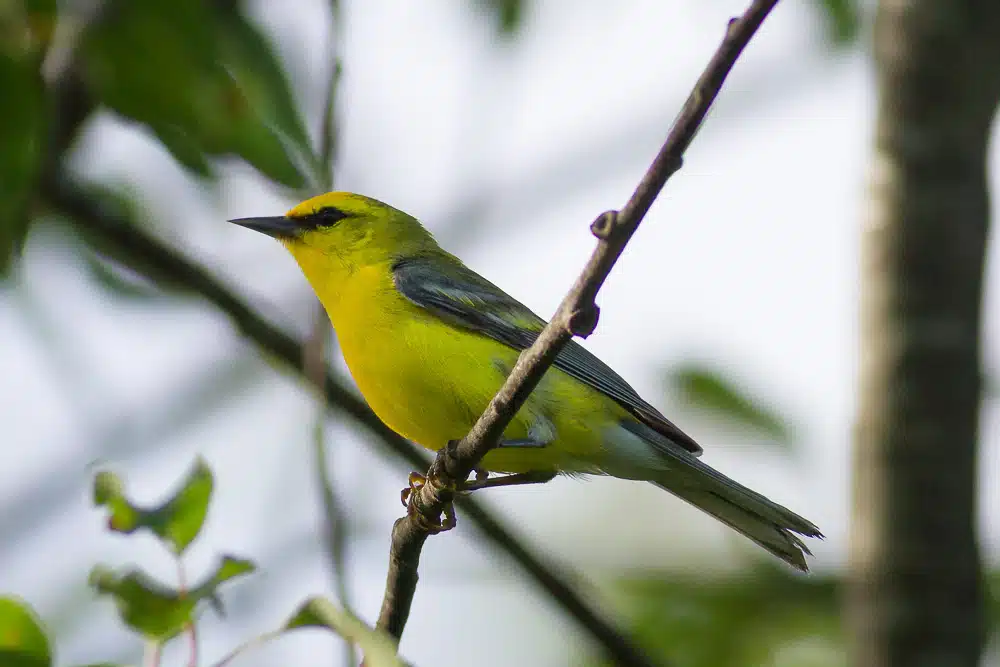
This warbler (Vermivora cyanoptera) which often sounds like insects when singing is known for having a bright yellow color.
Males and females are both yellow, with small differences such as having brighter plumage.
The underbelly is completely yellow, together with the head, including the crown.
The back of the bird has a yellow-green nuance with gray, green, and white wings.
A dark short bill is a further characteristic of males of the species.
Warblers of this family live and breed in the Eastern and Northeastern parts of the United States, heading South to overwinter.
Distribution – Eastern United States, Eastern Mexico, Belize, Eastern Panama
19. Saffron Finch
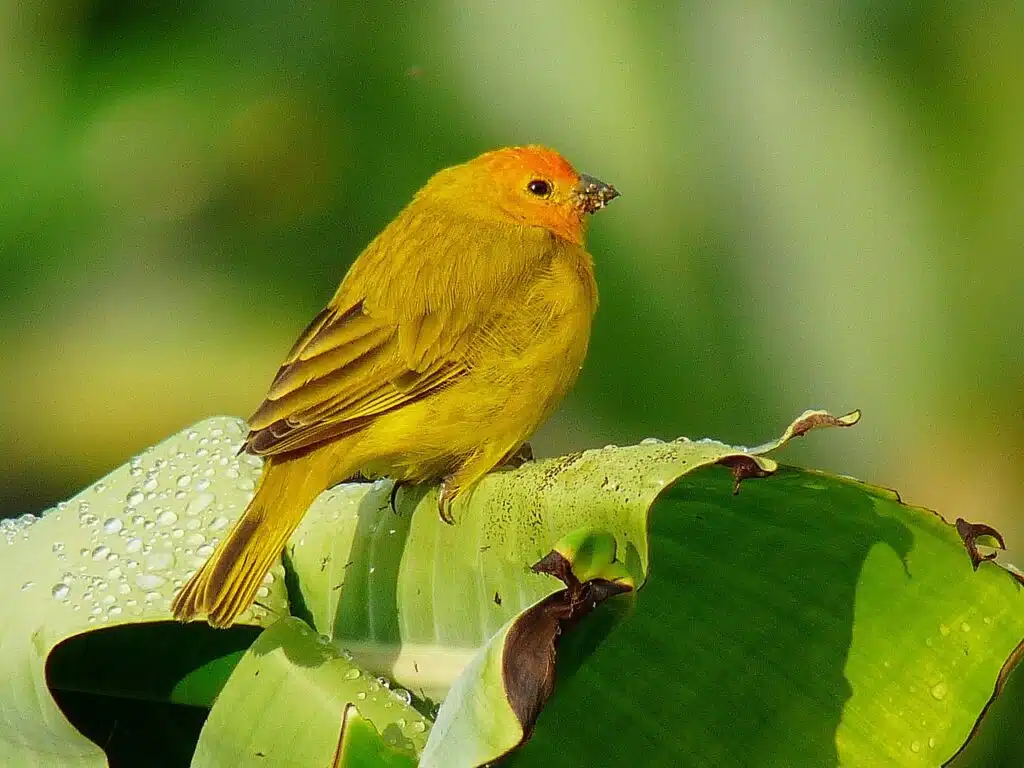
Saffron Finches (Sicalis flaveola) are native to South America yellow birds.
Male Saffron Finches are among the few mostly yellow species. The male bird has both a yellow body and yellow wings.
A bright yellow nuance is specific to its wings and belly while its head is yellow-orange into the breeding season.
Females are a bit darker, but still mostly bright. They have a white belly and green wings with yellow sections on the neck and upper back.
One plumage exception applies to female Saffron Finches in the Southern parts of the continent as their plumage is even darker.
Distribution – Ecuador, Colombia, Brazil, Paraguay, Uruguay, Argentina
20. MacGillivray’s Warbler
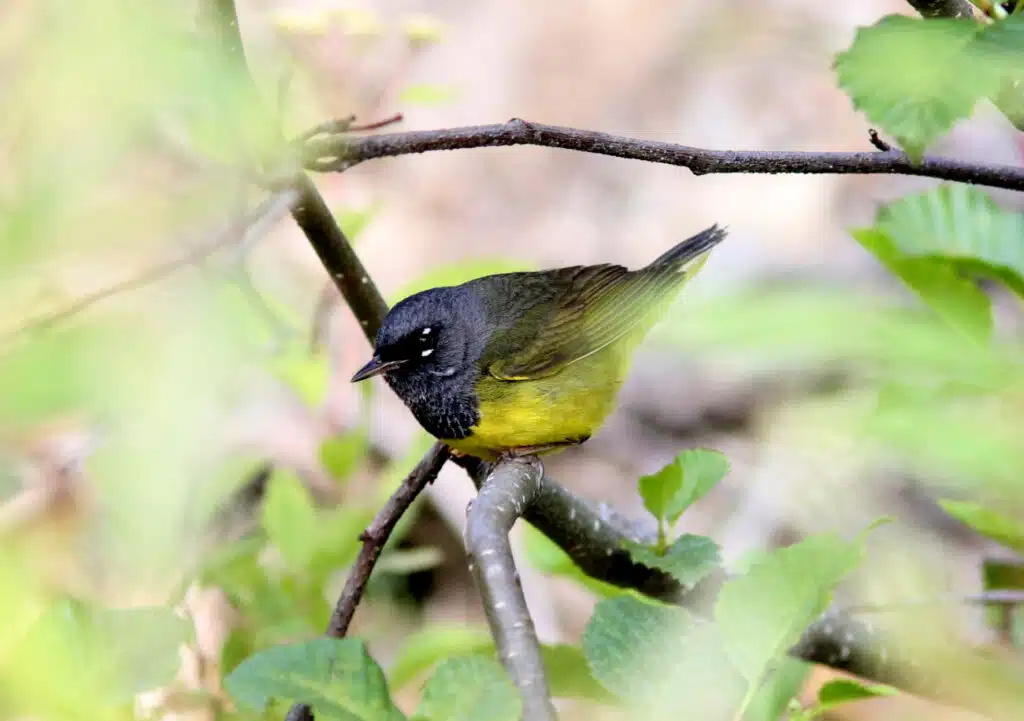
Western territories of North America are the home of The MacGillivray’s Warbler (Geothlypis tolmiei).
This species lives in woodlands and around woodlands, showing different levels of yellow plumage between males and females.
Males of the species show vivid yellow bellies with yellow margins of their black wings.
They have contrasting black heads and mostly black tails.
Females have a yellow color closer to green, often appearing lime green or olive. A gray head and olive wings are mostly an attribute of female plumage.
The size of these birds is similar to the size of other American warblers. They may reach a size of 5 inches at best.
Distribution – Western North America, Western Central America
21. Scott’s Oriole
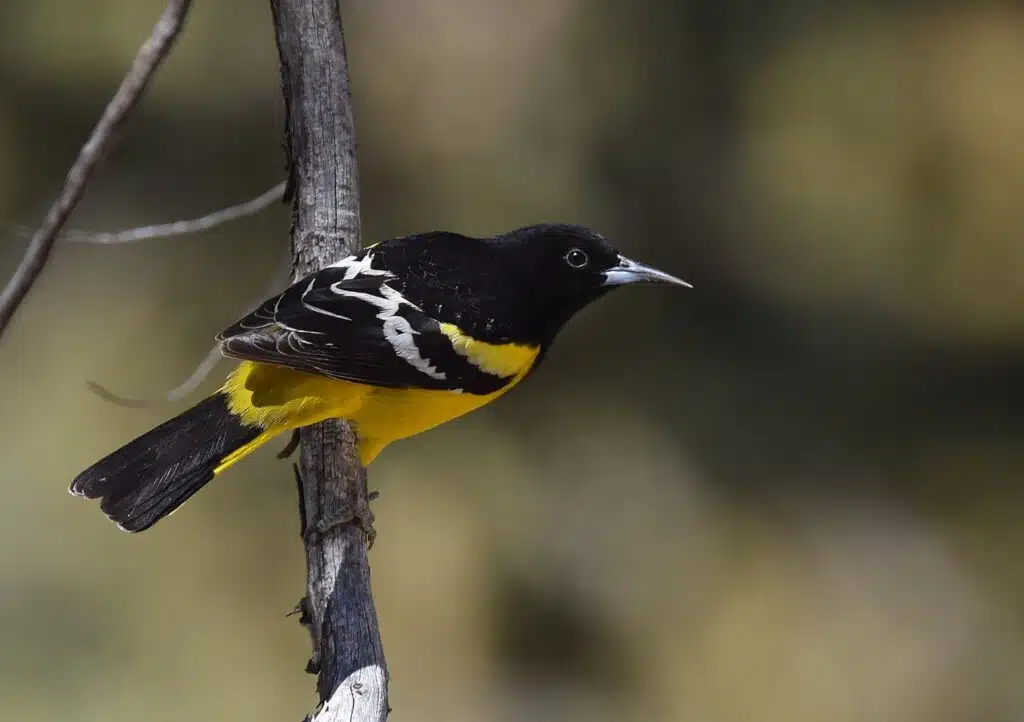
Southern and Southwestern US territories with yuccas are the main habitat of Scotts’ Oriole (Icterus parisorum).
Birds of the family are also present in Mexican territories rich in yuccas.
Birds of this genus show yellow colors in males. Their bellies are mostly bright yellow with additional yellow sections on the back and wings.
The head and chest of males are mostly black.
Females are dominated by olive-to-green plumage. They show a darker nuance on the head and a brighter nuance on the bellies. Their wings are mostly gray,
Distribution – Southwestern United States, Mexico
22. Tropical Kingbird
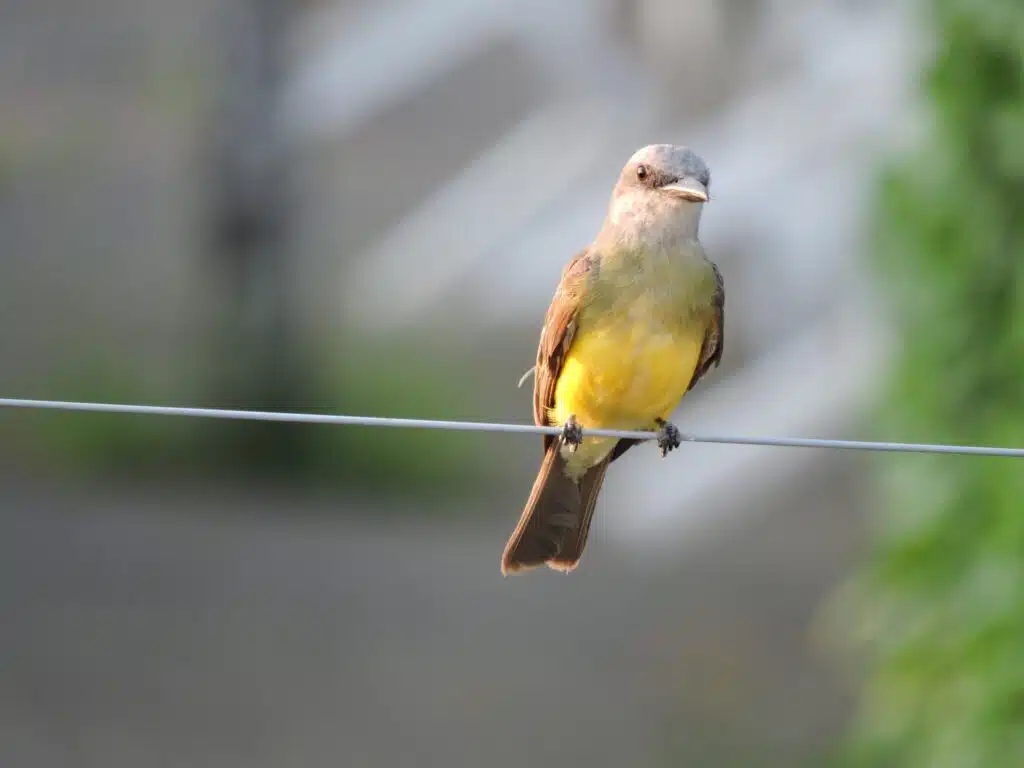
Tropical Kingbirds (Tyrannus melancholicus) are native to the tropical woodlands of The Americas.
While a rare sight in The United States, these birds often migrate along the coastal areas making their way up to Canada on the West Coast.
A bright yellow belly coloring is specific to these birds. Their heads are gray to white, almost appearing white.
The wings of the species have different colors. These colors vary from gray, yellow-green, to dark brown.
Their tails are also mostly dark gray.
Distribution – Western US Coat, Eastern US Coast, Mexico, Belize, Guatemala, Nicaragua, Panama, Ecuador, Colombia, Brazil, Argentina, Paraguay
23. Kentucky Warbler
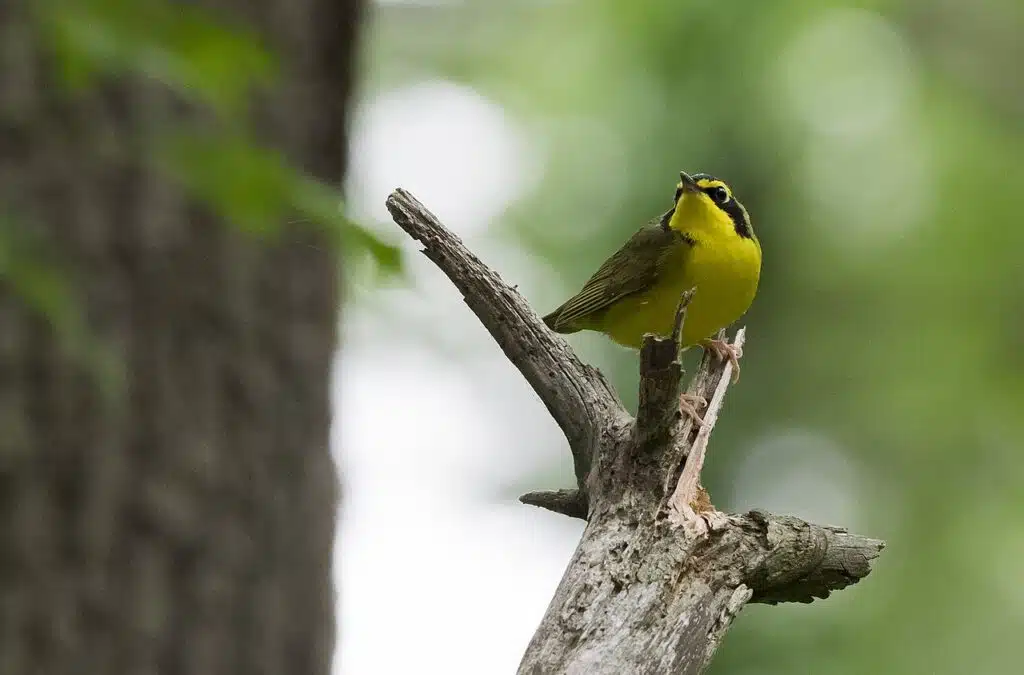
Southeastern US states (except Florida) are home to the singing Kentucky Warblers (Geothlypis formosa).
Birds of this genus show extensive yellow plumage while spending most of their lives on the ground.
A yellow belly and neck are specific to the species. Males have black patches around the eyes with yellow stripes above the eyes.
A dark gray green crown with similar coloring on the wings is further specific to these birds.
Females of the species are responsible for building the nests and incubation.
Once the young birds emerge, they migrate Southwards.
Distribution – Eastern and Southeastern United States, Central America, The Caribbean
24. Western Kingbird
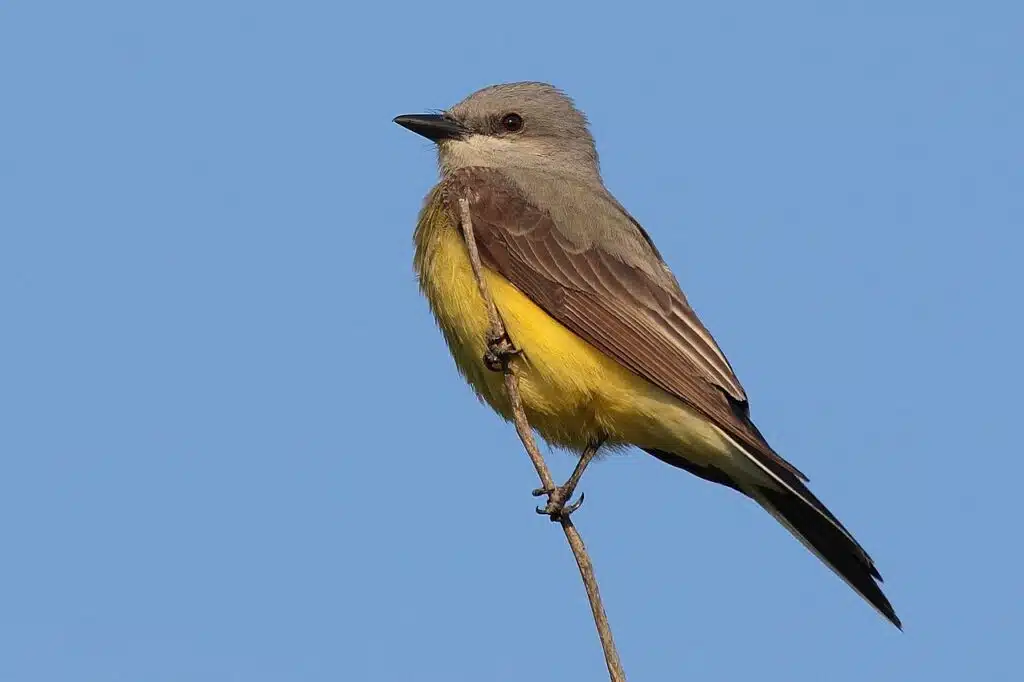
Mostly found in the Eastern parts of North America, Western Kingbirds (Tyrannus verticalis) are among the aggressive yellow birds of the US.
These birds have a reputation for being aggressive against all types of animals and birds a few times their size.
Males of the species are identified by a yellow ventral color and yellow coloring on the face.
Its head is gray while its bill is dark gray.
Birds of this species have dark wings usually showing a combination of gray, brown, and white feathers.
Distribution – Western Canada, Western United States, Central America
25. Western Meadowlark
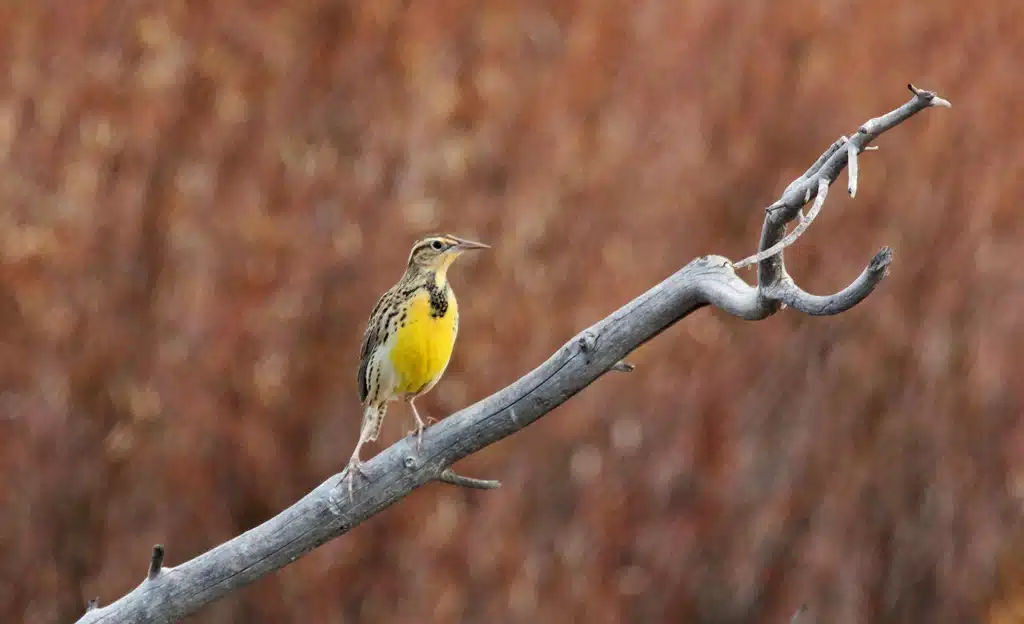
Open grassland across Western North America is home to The Western Meadowlark (Sturnella neglecta).
This bird species is one of the most common resident species in the Western, Southern, and Midwestern US states.
Only its Northern US state populations and birds in Canada migrate to warmer climates either within The US or in Mexico.
This species has vivid yellow coloring across the neck and belly. Small black spots are seen across its chest as well as along its upper body and wings.
The head of the species has a contrasting appearance with black stripes and a small yellow around the beak.
Distribution – Western North America, Southern US, Mexico
26. Great Crested Flycatcher
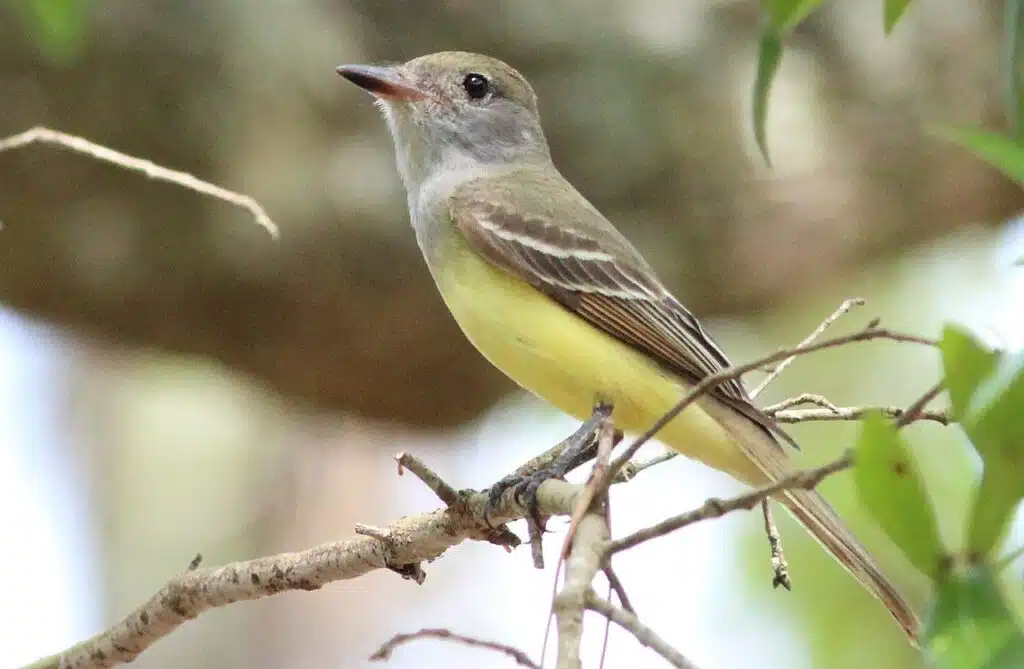
A species named after its large crest, The Great Crested Flycatcher (Myiarchus crinitus) is native to various woodlands in North America.
Its expansive range means this species is not difficult to spot and identify.
A yellow color is specific to its belly and its head and crest have a gray or gray-brown color.
Much of their wings are also brown or light brown.
This species is migratory, leaving towards Central and South America for the coldest months of the year.
Distribution – Eastern Canada, Eastern United States (West of The Rocky Mountains), Central America
27. Eastern Meadowlark
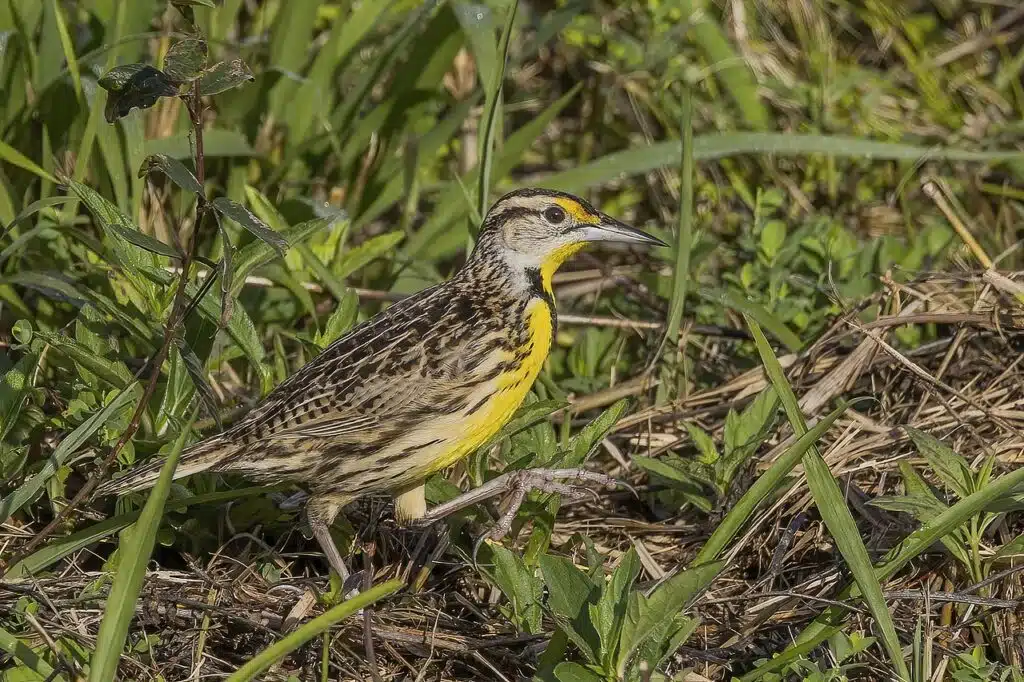
A mostly yellow underside is characteristic of The Eastern Meadowlark (Sturnella magna), a species found across grasslands in the Eastern US.
This species is further identified by its V-shaped black chest mark.
Further additional black marks are specific to its upper body and wings, which have a white to gray base color.
Its head also shows a combination of black and gray colors with yellow sections next to its gray beak.
The species tends to show darker gray plumage outside of the breeding season.
Distribution – Eastern North America, Central America, Northern South America
28. Yellow-breasted Chat
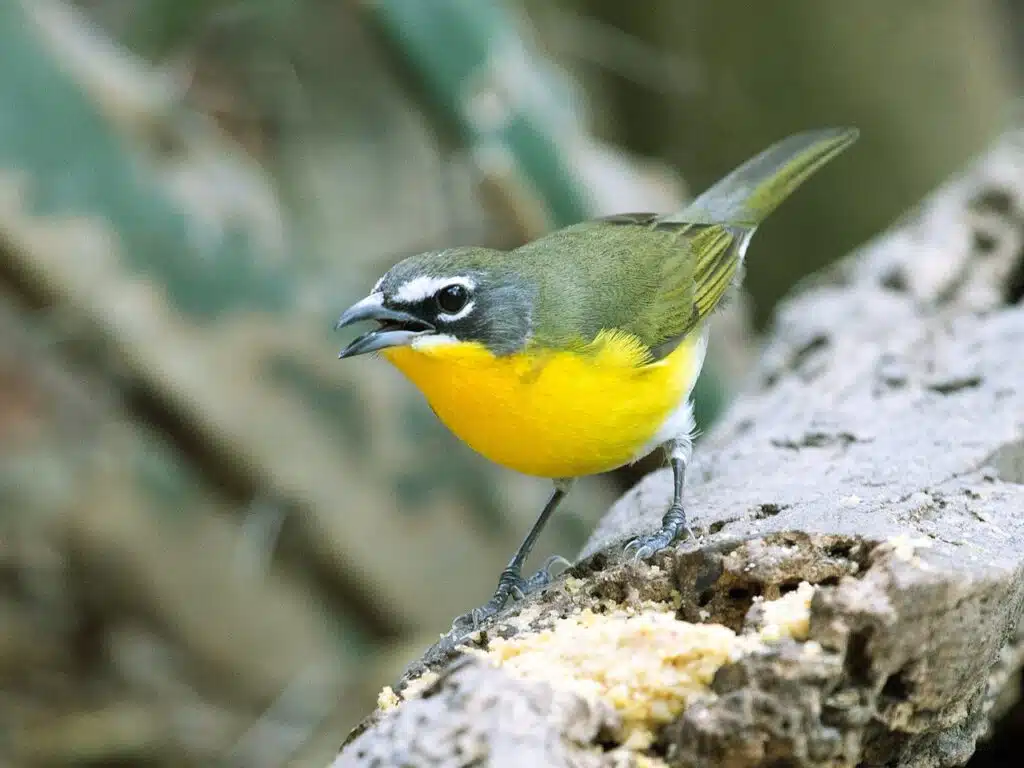
Yellow-breasted Chats (Icteria virens) are widespread across North America, including Southern Canada.
This species lives in open areas with plenty of vegetation, away from urban areas.
A singing species, Yellow Breasted Chats are named after their yellow chests and upper bellies.
A white color is specific to the lower underbelly while males can show an additional orange-brown spot on the chest when breeding.
The head and wings of these singing birds are mostly gray and brown while their beaks are black.
As a migratory species, Yellow-breasted Chat birds move to Central America to overwinter, typically in small groups.
Distribution – throughout the US, Southern Canada, Mexico, Guatemala, Costa Rica
29. Great Kiskadee
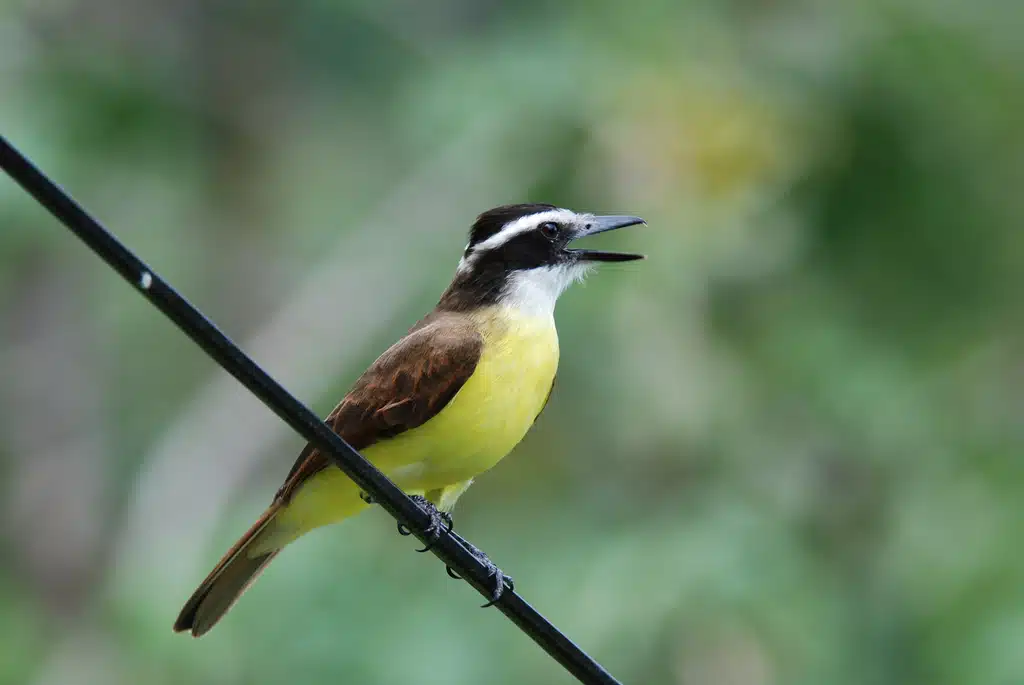
Great Kiskadees (Pitangus sulphuratus) are only present in remote Southern US territories in North America.
This bird is a constant presence in Southern Texas and a populous bird in Central and South America.
Woodlands with dense vegetation, as well as areas of woodlands close to lakes, ponds, and rivers, are among its preferred habitats.
Yellow plumage is seen all across its underside. Its wings are mostly brown, as is its tail.
These birds also show white and black contrasting colors with black beaks.
Males also show yellow crests during the breeding season.
Distribution – Texas, Central America, South America
30. Yellow-throated Vireo
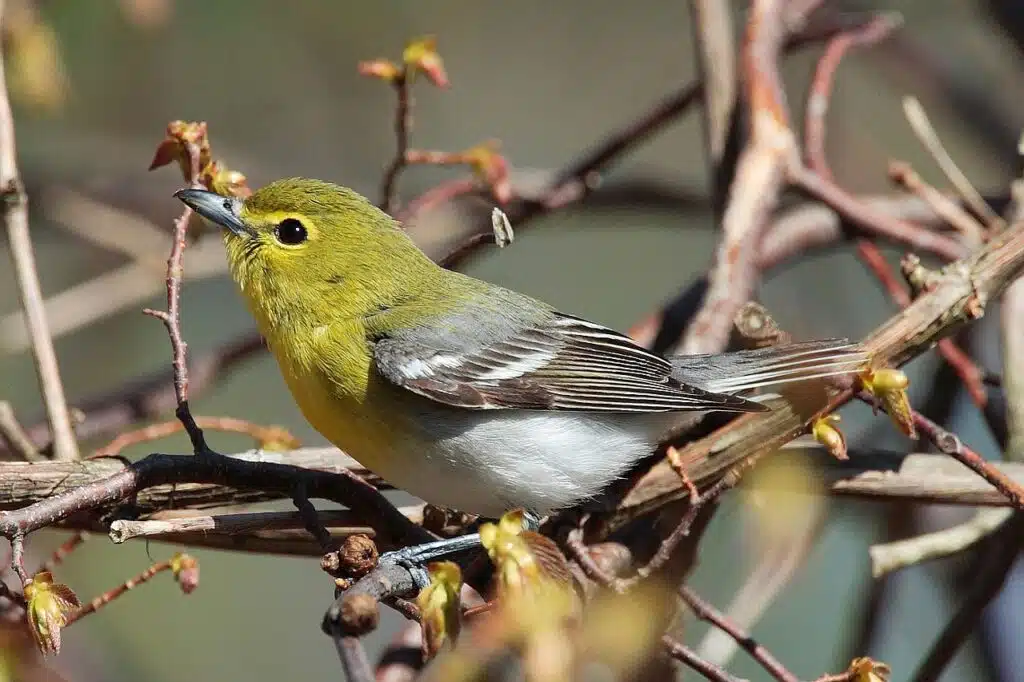
Yellow-throated Vireos (Vireo flavifrons) are mostly yellow, as their name implies.
Their chest, neck, and head are mostly yellow. White color is specific to the underbelly.
This species also shows a yellow to olive upper back and darker mostly brown wings with additional white and gray feathers.
Only found in woodlands, Yellow-throated Vireos are migratory species. Their migration routes are long as some reach South America to warmer tropical climates to overwinter.
Distribution – Eastern United States, Central America, West Indies, Northwestern South America
31. Warbling White-Eye
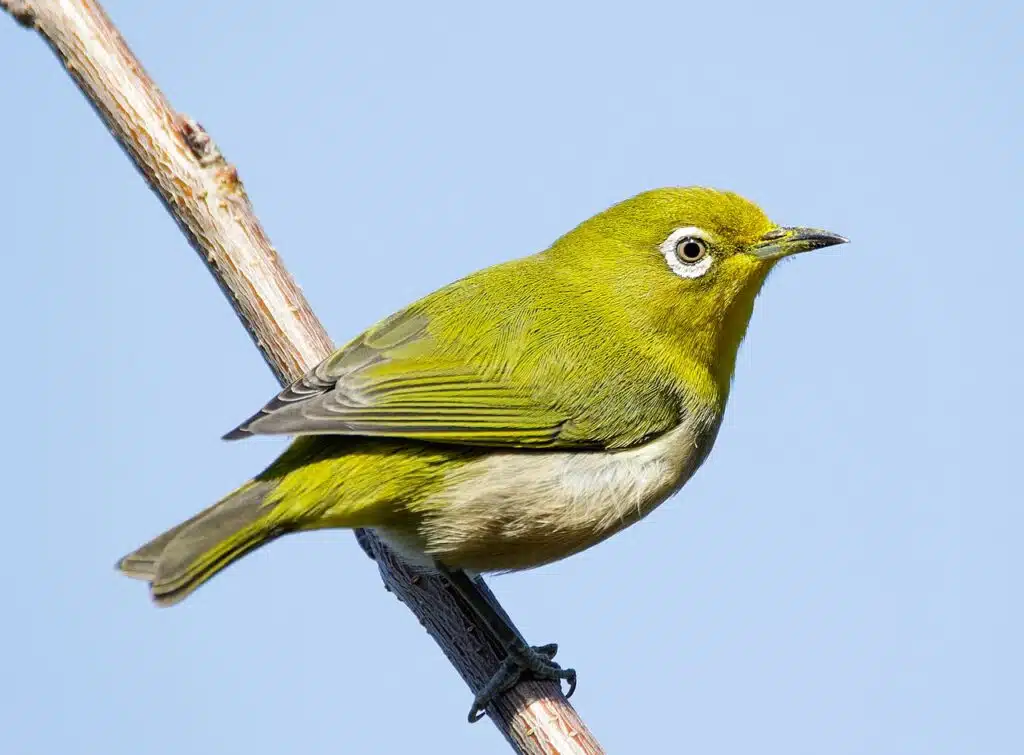
An East Asian species, Warbling White-Eyes (Zosterops japonicus) has yellow and yellow-green plumage.
These birds show white undersides and green or yellow upper plumage. Their heads, wings, and backs can be yellow-green across males and females.
White rims are seen around its eyes.
The female of the species also shows lateral yellow plumage on the chest.
Often found in woodlands, these singing birds are known to have specific breeding rituals which involve dancing, flying, flapping their wings, and nodding.
A species spending a lot of time both on trees and on the ground, Warbling White-Eyes usually feed in small groups.
Each group of the species is dominated by one bird which assesses its physical dominance over the others.
They may also re-purpose old Warbling White-Eye nests on occasion.
Distribution – Japan, South Korea, Eastern China, Taiwan, Indonesia, Philippines
32. Audubon’s Oriole
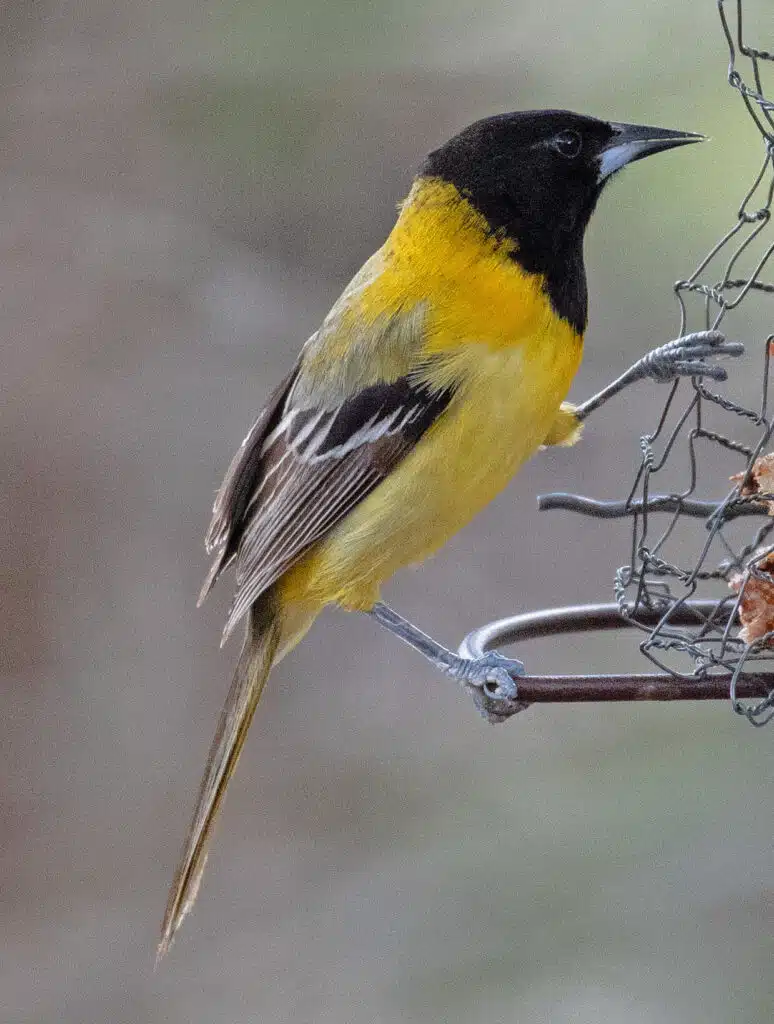
This species of yellow bird (Icterus graduacauda) is native to Central America with a confirmed presence in Southern Texas.
No other US state has confirmed Audubon’s Orioles outside a few strays.
This species has yellow and black plumage. Its upper back and belly are bright yellow while its head and chest are black.
Black and yellow contrasting feathers form its wings while its tail is mostly black.
This species has a slightly elongated beak used to grab insects and dig them out from various materials such as dead wood.
Birds of this species scatter through different piles of leaves and wood looking for insects.
On occasion, this species may also eat fruits whenever it cannot find insects or different spiders.
A resident in its habitat, the bird doesn’t migrate and it lays small clusters of eggs twice per year.
Distribution – Southern Texas, Eastern Mexico, Western Mexico
33. Yellow-fronted Canary
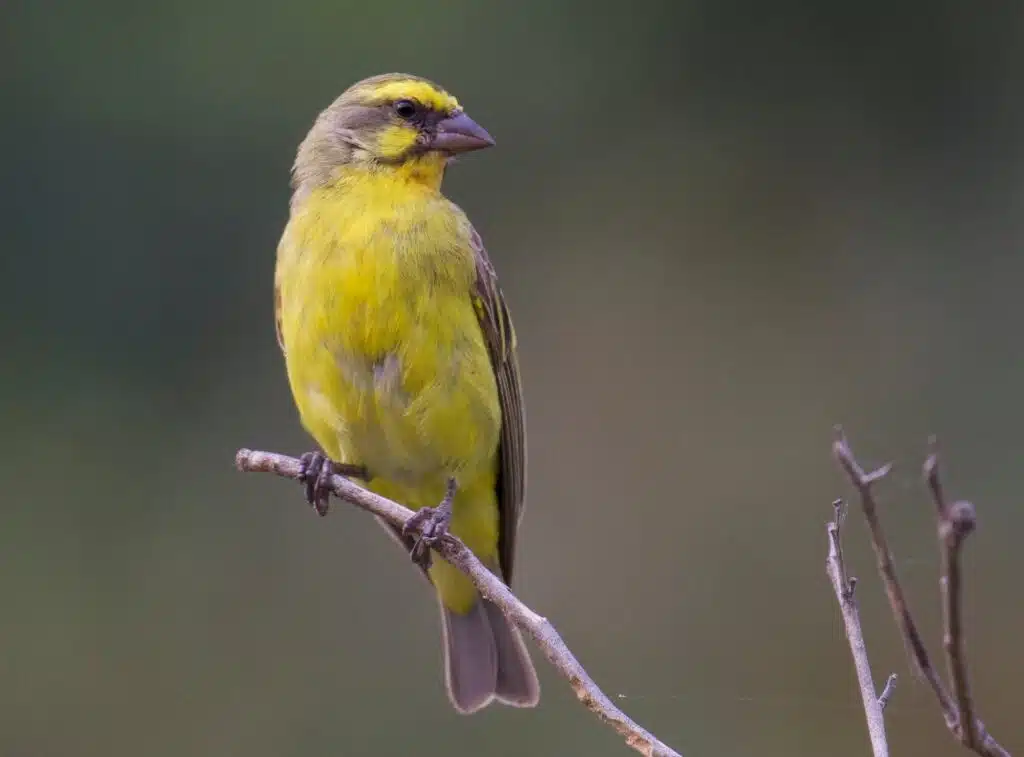
Both male and female Yellow-fronted Canaries (Crithagra mozambica) have a similar yellow appearance.
The nuance of the plumage is the only difference between the sexes as females have a brighter appearance.
Yellow is dominant across the belly of the bird, its neck, and its face. Black stripes and gray plumage is seen across its back and head. The wings show a combination of black and gray colors with a few yellow sections.
10 Yellow-fronted Canary subspecies are confirmed for this group of birds. They are all found mostly across Africa.
Also introduced to warm climates around the world such as Hawaii, this species is known to feed on seeds.
It doesn’t have a particular preference for seeds, showing opportunistic feeding habits.
Distribution – East Africa, West Africa, Hawaii
34. Hawaiʻi ʻAmakihi
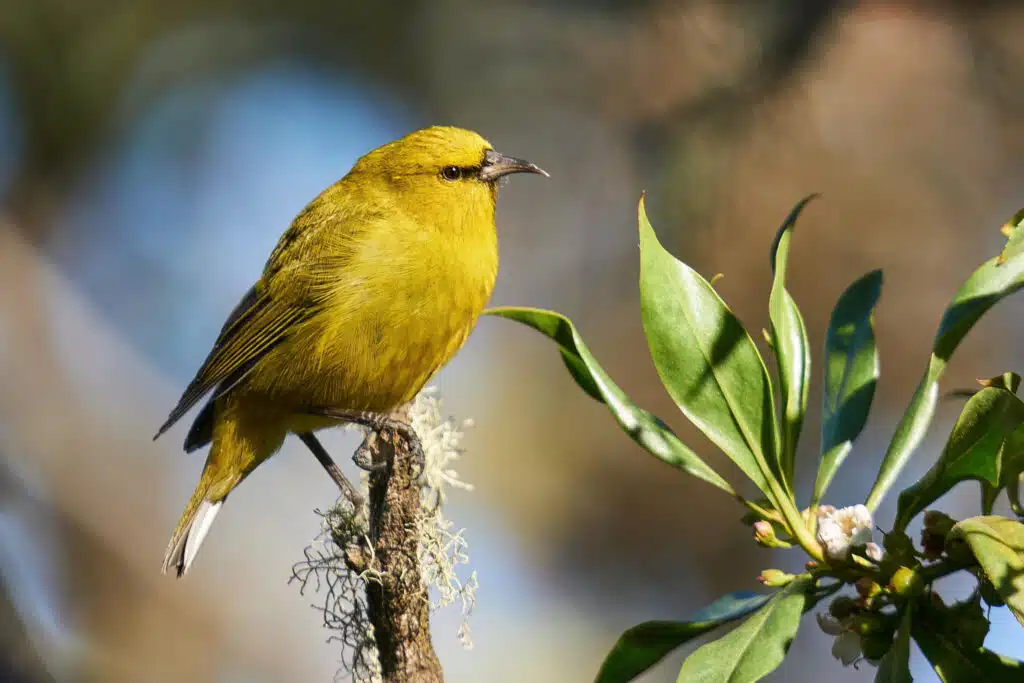
Native to Hawaii, this bird species (Chlorodrepanis virens) show mostly yellow coloring in the case of males
The underbelly, chest, head, and upper back are mostly yellow while the wing tips are mostly gray.
Females have similar color patterns but are rather bright green than yellow.
Much of the coloring of these species remains the same throughout the year. The Hawaiian habitat allows the species to breed almost throughout the year.
The unique warm habitat of the islands means Hawai’i ‘Amakihi birds are residents as they never migrate.
Both males and females have curved beaks, ideal for a varied diet. They feed on fruits, nectar, and insects.
Various elevation woodlands across the islands represent ideal habitats for these birds.
Distribution – Hawaii
35. Swinhoe’s White-Eye
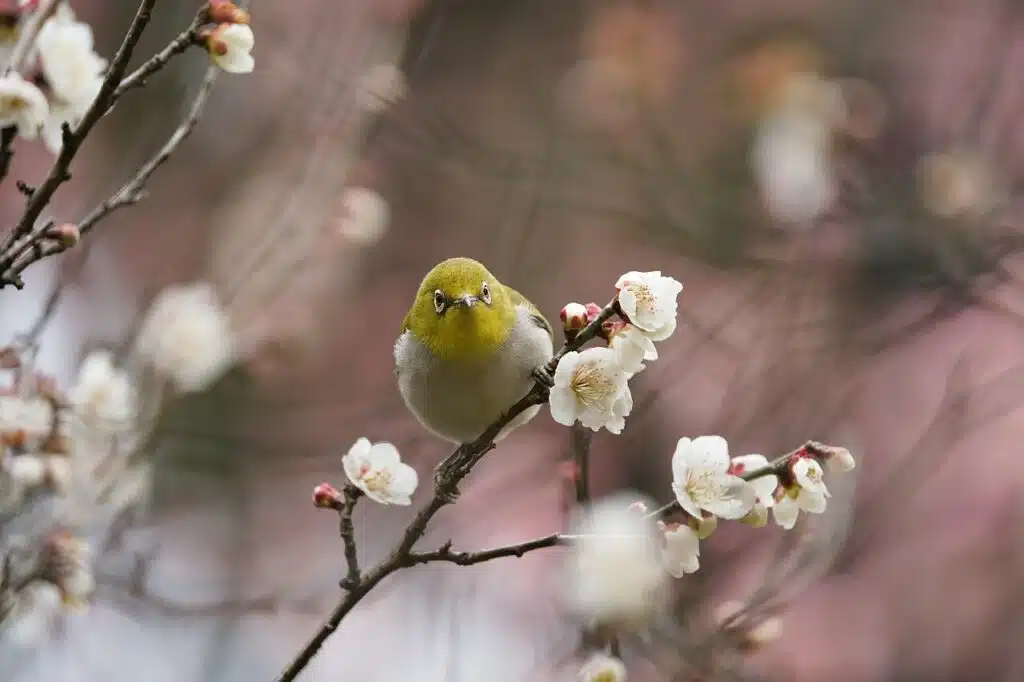
A yellow head is specific to Swinhoe’s White-Eye (Zosterops simplex) male and female.
The species has a yellow neck and yellow wing in the case of males and yellow-green base plumage in the case of females.
White plumage underbellies contrast the yellow-green upper of the birds.
This species is further characterized by the white rings around its eyes.
A native species in East and Southeast Asia, Swinhoe’s White-Eye is categorized into 6 subspecies.
Depending on its location, the bird can be found across urban areas or only in natural reservations in areas where they live in small numbers.
Distribution – East China, South Korea, Thailand, Vietnam, Cambodia, Malesia
36. Golden-crowned Warbler
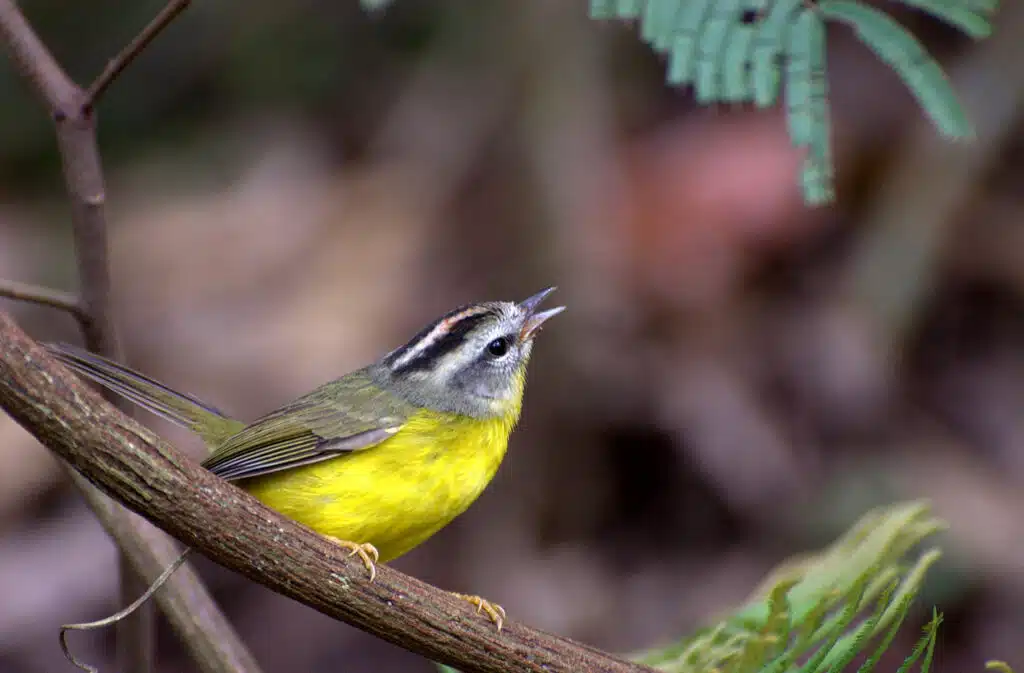
A South American and Central American native, Golden-crowned Warblers (Basileuterus culicivorus) are named after their yellow-golden color.
These birds grow to around 5 inches, similar to warblers in North America.
Male Golden-crowned Warblers are known for their yellow bellies, chests, and necks. Additional yellow-gray sections are seen on the wings and tails while the head is black and white.
Females have white underbellies, gray-white heads, olive wings, and tails.
This singing bird makes high-pitched noises and is known to eat insects and spiders.
3 large subspecies are noted for The Golden-crowned Warbler. They are divided by region and show plumage differences on the head and underbellies.
Distribution – Central America, South America
37. Social Flycatcher
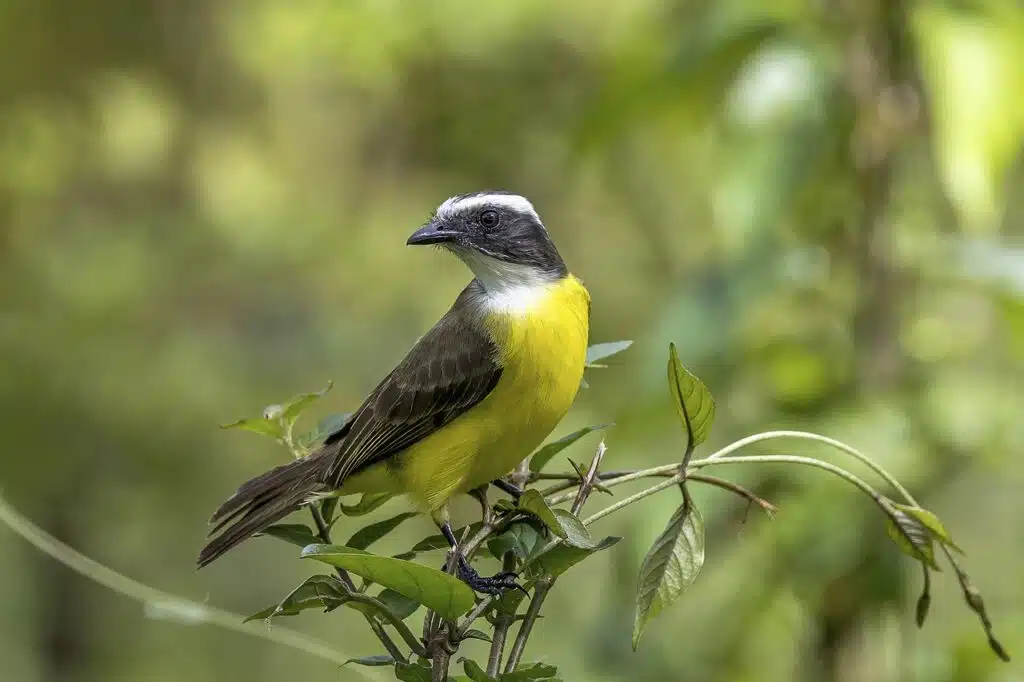
Social Flycatchers (Myiozetetes similis) spend most of their lives in Central and South American woodlands.
They are always present high up on trees, often with birds of other species. They even feed on fruits from birds of other species.
Social Flycatchers are solitary birds that may live in pairs, despite their name.
Male and female Social Flycatchers have vivid yellow underbellies. They show a dark wing and a gray and white striped head.
The beak of the species is short and wide.
Often mistaken for other birds, this yellow flycatcher further differentiates itself by size as it grows to a maximum size of 7.9 inches.
The size and coloring of the species often confuse the species with other striped-head birds with yellow bellies such as The Gray-Capped Flycatcher also found in Panama, Ecuador, and Brazil.
Distribution – Mexico, Panama, Ecuador, Colombia, Brazil, Peru
38. Streak-backed Oriole
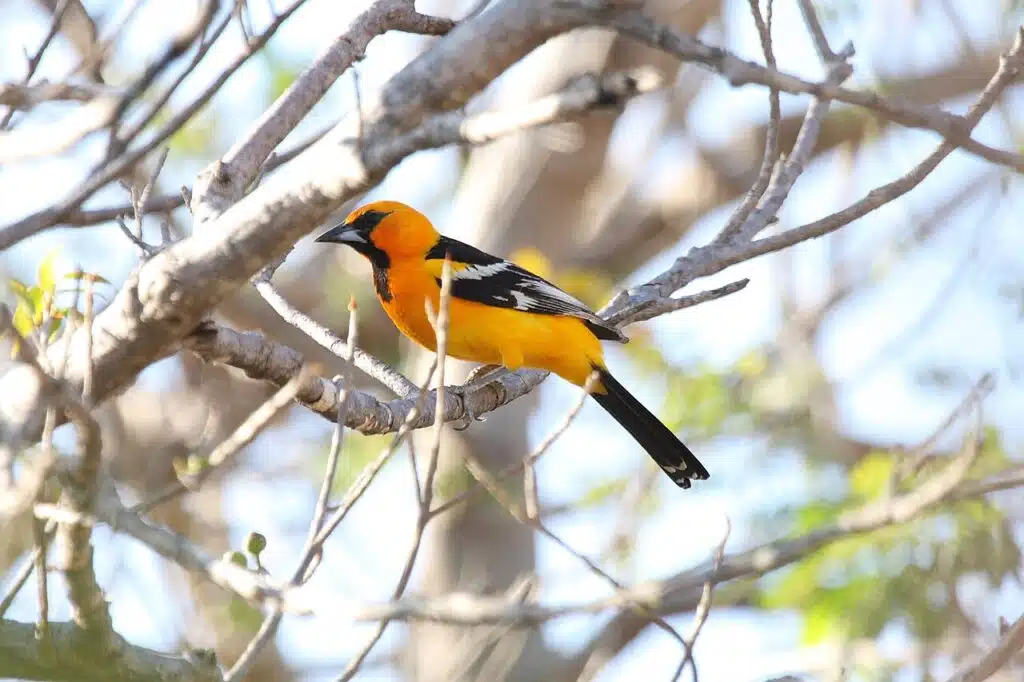
Streak-backed Orioles (Icterus pustulatus) show a combination of orange and yellow plumage depending on the season.
This species has a tangerine color but also comes in yellow-orange outside of its breeding stage.
Yellow plumage tends to dominate the underside of the bird while its wings and head show a more orange nuance.
Its wings are all black and white while its face shows a black mask.
Much of the range of Streak-backed Orioles includes Western territories across Central America.
Small numbers of these birds are also seen in the Southwestern United States.
Occasional sightings include the Southern parts of California, Arizona, New Mexico, and Texas.
Distribution – Mexico, Guatemala, Nicaragua, Costa Rica, Southwestern United States
39. Oʻahu ʻAmakihi
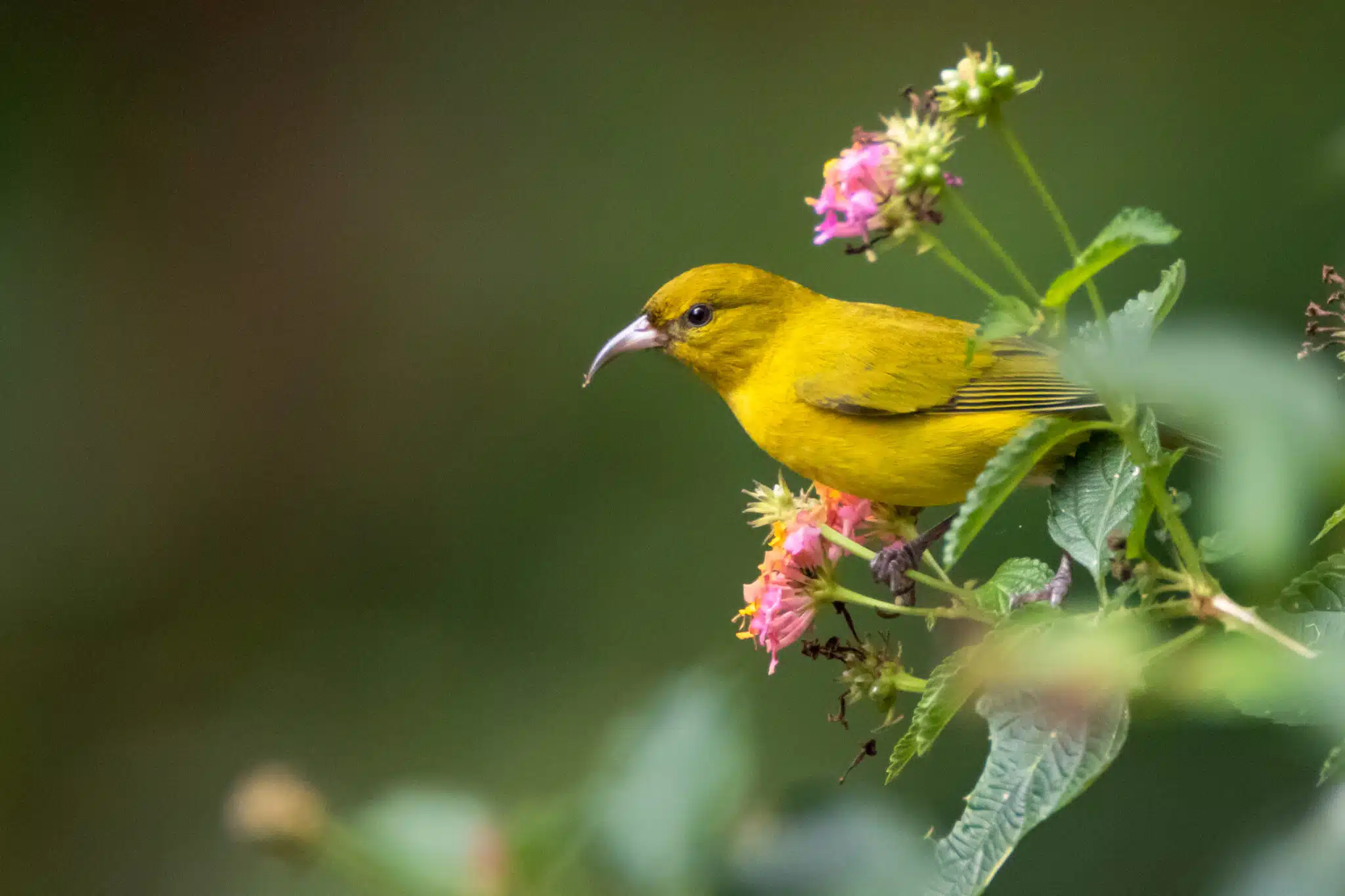
A Hawaiian species, The O’ahu ‘Amakihi (Chlorodrepanis flava) is one of the local yellow birds found in forests.
This species shows yellow ventral coloring, a gray head, and gray wings.
Its elongated beak is curved and adapted to catching insects. O’ahu ‘Amakihis can dig out insects under tree bark.
Furthermore, the beak of the species also allows them to drink plant nectar. The nectar of various local myrtles is preferred by these birds.
Distribution – Hawaii
40. ʻAkiapolaʻau
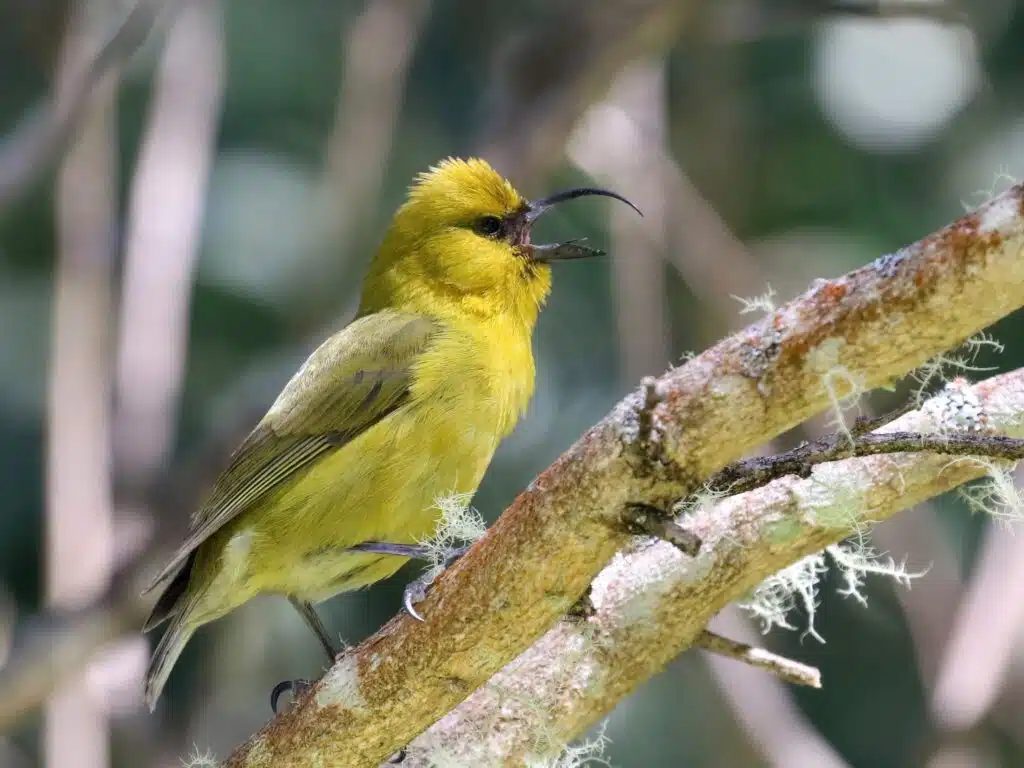
ʻAkiapolaʻau (Hemignathus wilsoni) is among the rare yellow birds of Hawaii. This species only lives in forests at high elevations, away from inhabited areas.
It changes its plumage from pale green to mostly yellow with green wings as it matures.
This species also has a yellow head and curved black beak.
Only living up on trees, the singing bird is specialized in eating insects and plant nectar.
The breeding habits of the species may be responsible for its low numbers, even across Hawaii.
Females lay a single egg after breeding, which has low survival chances.
Male birds are known to have multiple songs. They have whistling and warbling sounds heard during the breeding period.
Distribution – Hawaii
41. Eastern Yellow Wagtail
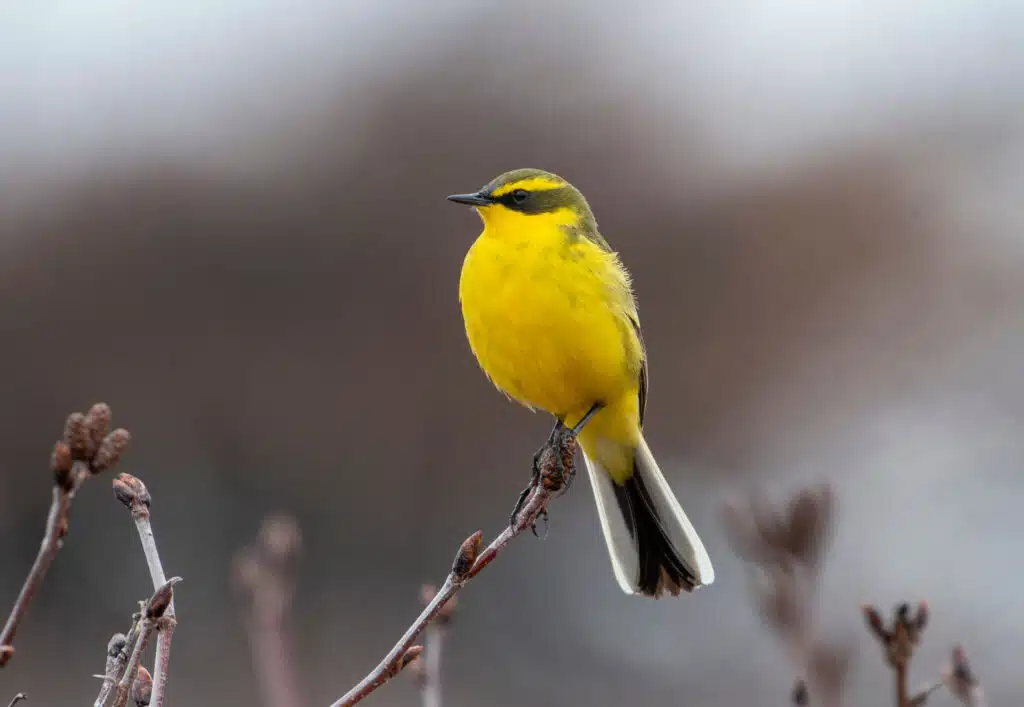
Yellow dominates the neck, chest, and underbelly of The Eastern Yellow Wagtail (Motacilla tschutschensis).
The back and the wings have a green-yellow color while its head is almost completely gray. Lateral white stripes run along its eyes.
This is a species named after the Eastern territories it occupies across Asia.
There are 5 Eastern Yellow Wagtail subspecies and 2 of them are found in Siberia.
Meadows and scarce vegetation areas around water are among its preferred habitats.
Most of its subspecies migrate to the Southern parts of the continent to overwinter.
Distribution – Siberia, Southeast Asia
42. Island Canary
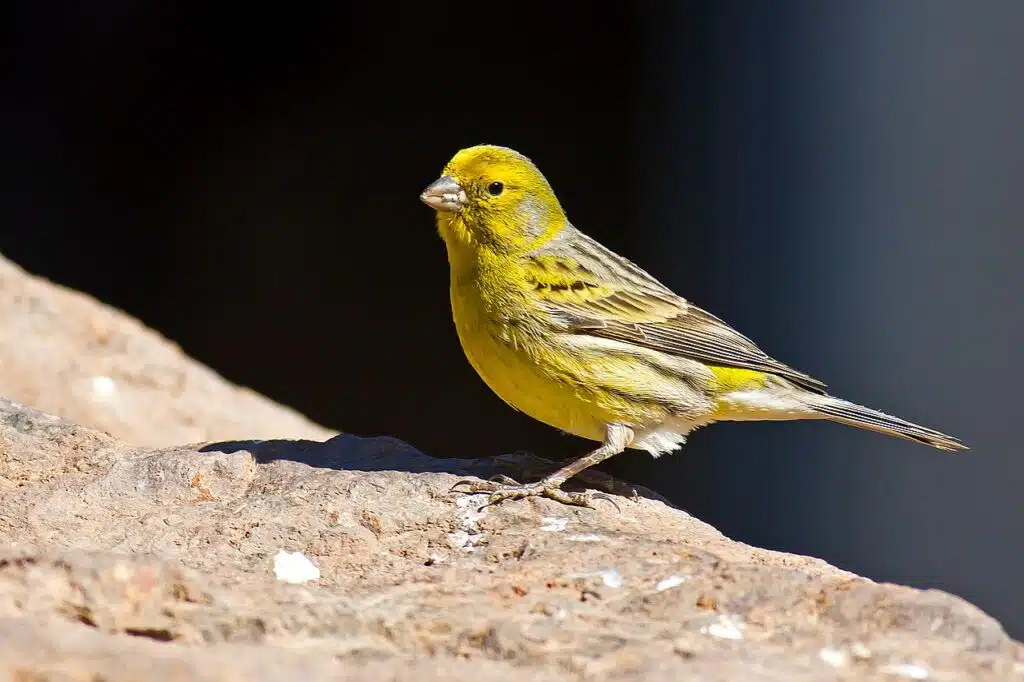
Dark yellow plumage is characteristic of The Island Canary (Serinus canaria). This is one of the rarest types of yellow birds in the world, as it only lives in The Canary Islands and small nearby islands.
While not completely yellow, the bird also shows black and gray wings as well as mostly gray plumage in its juvenile days.
In captivity, this species may be seen in different other nuances as well. All pale-yellow plumage is one of the nuances the Island Canary can be seen in.
Seen in small groups, the bird is mostly tied to the forests around its native islands.
Distribution – The Canary Islands, Madeira, Tenerife
43. ‘Anianiau
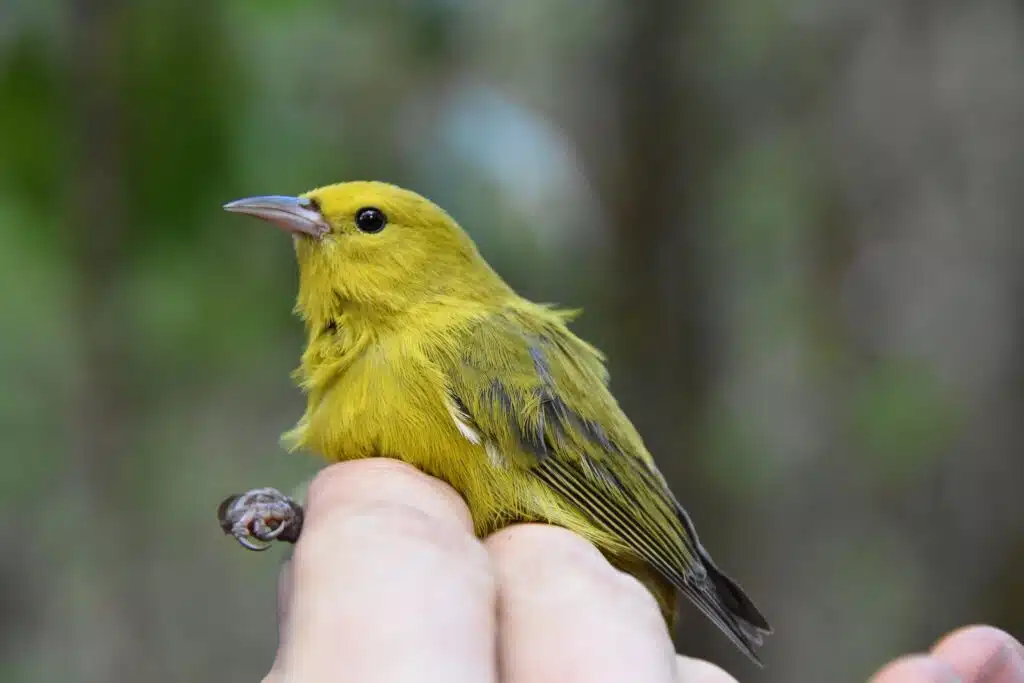
Native to Kauai, ‘Anianiau (Magumma parva) is one of the smaller yellow birds on the island.
It grows to a maximum size of 3.9 inches and shows some resemblance between males and females.
Yellow coloring is dominant in males. It shows these birds have a yellow belly, head, and back.
Females have yellow-green plumage with dark green wings.
Only found deep in the forests of the island at higher elevations, this species has once been believed to be extinct.
Even today, its numbers are reduced but stable. They can be heard singing with their high-pitched songs.
Various local plants such as those in the Myrtle family offer a nectar source for these birds.
Apart from nectar, ‘Anianiaus also eat spiders and small insects.
Distribution – Kauai Island in Hawaii